Form 8-K DYCOM INDUSTRIES INC For: May 26

Investor Presentation June 2022 1 Exhibit 99.1

Important Information Caution Concerning Forward-Looking Statements This presentation contains forward-looking statements as contemplated by the 1995 Private Securities Litigation Reform Act. These statements include those related to the outlook for the quarter ending July 30, 2022 found within this presentation. These statements are subject to change. Forward-looking statements are based on management’s current expectations, estimates and projections. These statements are subject to risks and uncertainties that may cause actual results for completed periods and periods in the future to differ materially from the results projected or implied in any forward-looking statements contained in this presentation. The most significant of these risks and uncertainties are described in the Company’s Form 10-K, Form 10-Q, and Form 8-K reports (including all amendments to those reports) and include the duration and severity of a pandemic caused by COVID-19, our ability to comply with various COVID-19 legal and contractual requirements and the impacts that those requirements may have on our workforce and our ability to perform our work, vaccination rates in the areas where we operate, any worsening of the pandemic caused by increasing infection rates triggered by new variants, future economic conditions and trends including the potential impacts of an inflationary economic environment, customer capital budgets and spending priorities, the availability and cost of materials, equipment and labor necessary to perform our work, the adequacy of the Company’s insurance and other reserves and allowances for doubtful accounts, whether the carrying value of the Company’s assets may be impaired, the future impact of any acquisitions or dispositions, adjustments and cancellations of the Company’s projects, the related impact to the Company’s backlog from project cancellations, weather conditions, the anticipated outcome of other contingent events, including litigation, liquidity and other financial needs, the availability of financing, the Company’s ability to generate sufficient cash to service its indebtedness, restrictions imposed by the Company’s credit agreement, and the other risks and uncertainties detailed from time to time in the Company’s filings with the Securities and Exchange Commission. The Company does not undertake any obligation to update forward-looking statements. Non-GAAP Financial Measures This presentation includes certain “Non-GAAP” financial measures as defined by Regulation G of the SEC. As required by the SEC, an explanation of the Non-GAAP financial measures and a reconciliation of those measures to the most directly comparable GAAP financial measures are provided in the Company’s Form 8-K filed with the SEC on May 26, 2022 and on the Company’s Investor Center website at https://ir.dycomind.com. Non-GAAP financial measures should be considered in addition to, but not as a substitute for, the Company’s reported GAAP results. 2
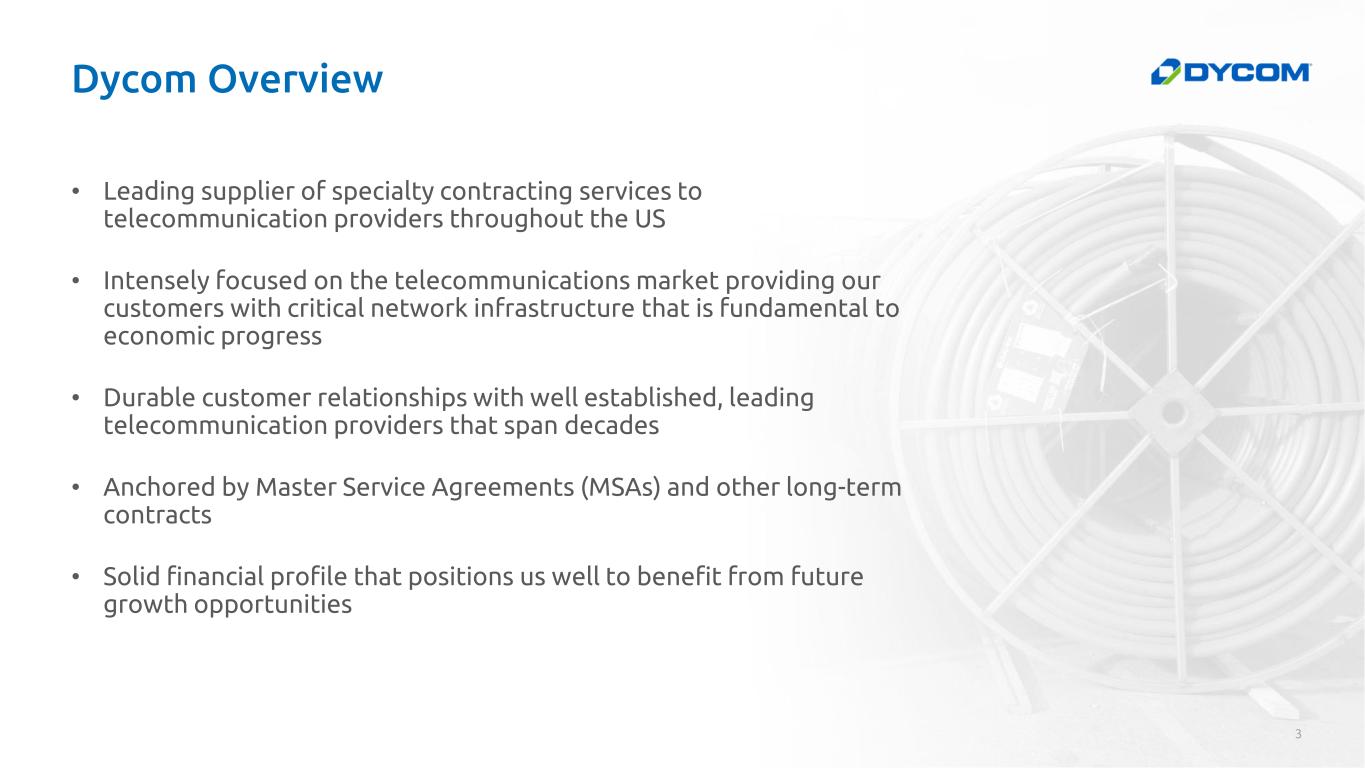
Dycom Overview • Leading supplier of specialty contracting services to telecommunication providers throughout the US • Intensely focused on the telecommunications market providing our customers with critical network infrastructure that is fundamental to economic progress • Durable customer relationships with well established, leading telecommunication providers that span decades • Anchored by Master Service Agreements (MSAs) and other long-term contracts • Solid financial profile that positions us well to benefit from future growth opportunities 3
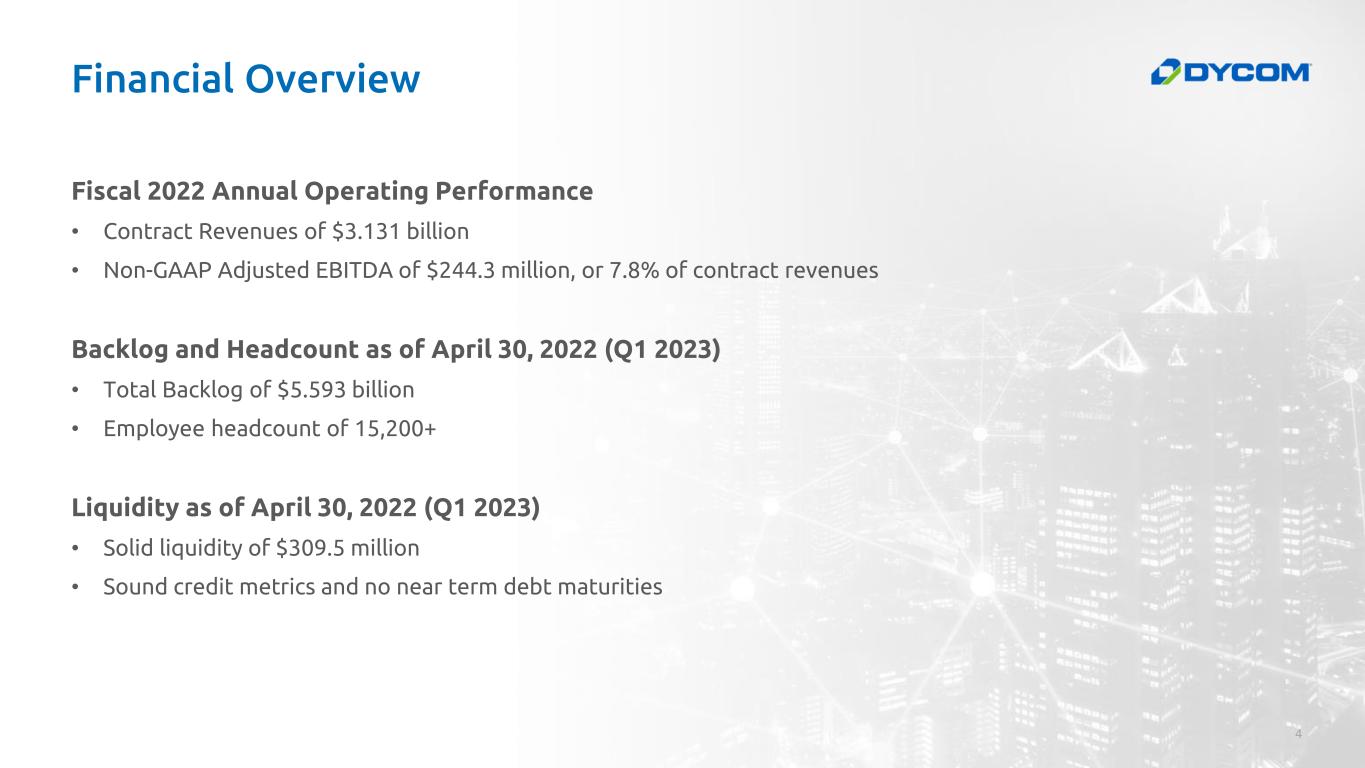
Financial Overview Fiscal 2022 Annual Operating Performance • Contract Revenues of $3.131 billion • Non-GAAP Adjusted EBITDA of $244.3 million, or 7.8% of contract revenues Backlog and Headcount as of April 30, 2022 (Q1 2023) • Total Backlog of $5.593 billion • Employee headcount of 15,200+ Liquidity as of April 30, 2022 (Q1 2023) • Solid liquidity of $309.5 million • Sound credit metrics and no near term debt maturities 4
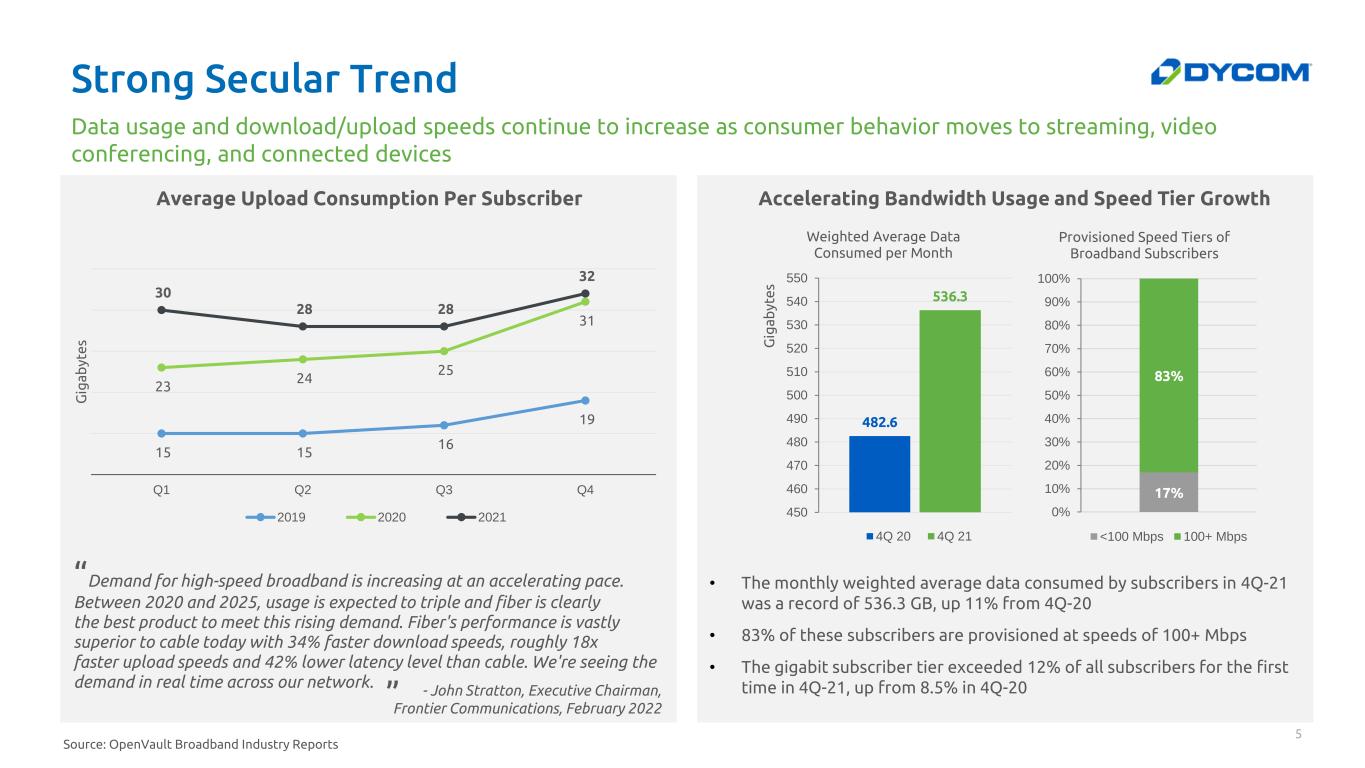
Strong Secular Trend 5 • The monthly weighted average data consumed by subscribers in 4Q-21 was a record of 536.3 GB, up 11% from 4Q-20 • 83% of these subscribers are provisioned at speeds of 100+ Mbps • The gigabit subscriber tier exceeded 12% of all subscribers for the first time in 4Q-21, up from 8.5% in 4Q-20 Accelerating Bandwidth Usage and Speed Tier GrowthAverage Upload Consumption Per Subscriber - John Stratton, Executive Chairman, Frontier Communications, February 2022 Data usage and download/upload speeds continue to increase as consumer behavior moves to streaming, video conferencing, and connected devices 17% 83% 0% 10% 20% 30% 40% 50% 60% 70% 80% 90% 100% Provisioned Speed Tiers of Broadband Subscribers <100 Mbps 100+ Mbps 482.6 536.3 450 460 470 480 490 500 510 520 530 540 550 G ig a b y te s Weighted Average Data Consumed per Month 4Q 20 4Q 21 15 15 16 19 23 24 25 31 30 28 28 32 Q1 Q2 Q3 Q4 G ig a b y te s 2019 2020 2021 Source: OpenVault Broadband Industry Reports “Demand for high-speed broadband is increasing at an accelerating pace. Between 2020 and 2025, usage is expected to triple and fiber is clearly the best product to meet this rising demand. Fiber's performance is vastly superior to cable today with 34% faster download speeds, roughly 18x faster upload speeds and 42% lower latency level than cable. We're seeing the demand in real time across our network. ”
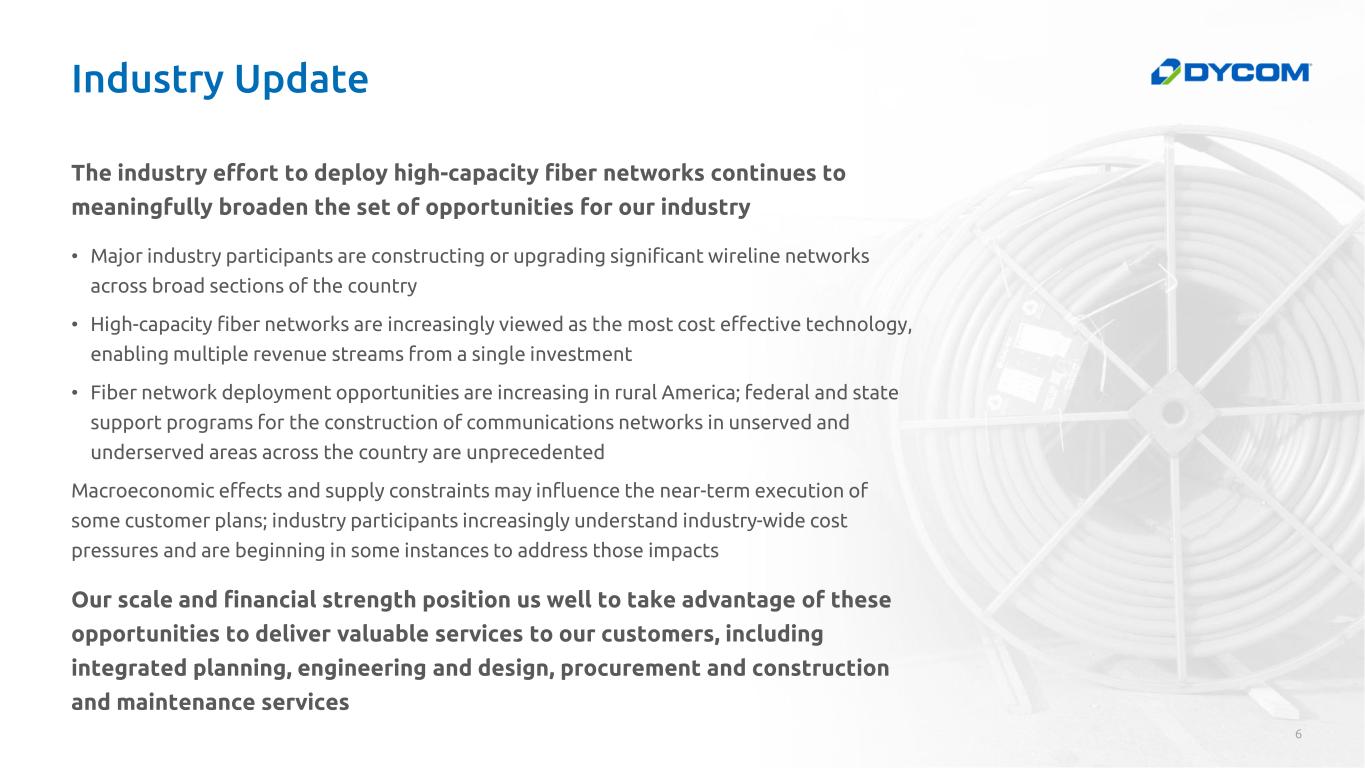
Industry Update The industry effort to deploy high-capacity fiber networks continues to meaningfully broaden the set of opportunities for our industry • Major industry participants are constructing or upgrading significant wireline networks across broad sections of the country • High-capacity fiber networks are increasingly viewed as the most cost effective technology, enabling multiple revenue streams from a single investment • Fiber network deployment opportunities are increasing in rural America; federal and state support programs for the construction of communications networks in unserved and underserved areas across the country are unprecedented Macroeconomic effects and supply constraints may influence the near-term execution of some customer plans; industry participants increasingly understand industry-wide cost pressures and are beginning in some instances to address those impacts Our scale and financial strength position us well to take advantage of these opportunities to deliver valuable services to our customers, including integrated planning, engineering and design, procurement and construction and maintenance services 6
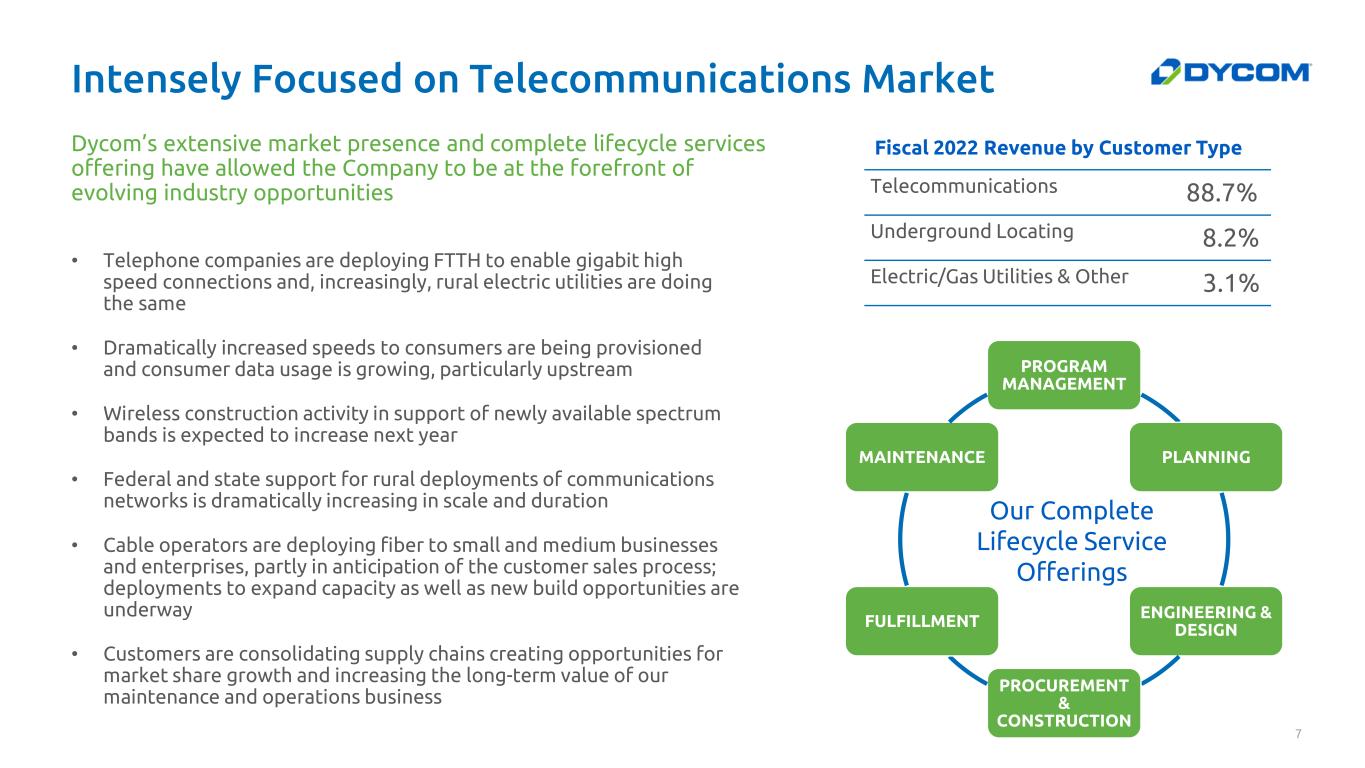
Intensely Focused on Telecommunications Market Dycom’s extensive market presence and complete lifecycle services offering have allowed the Company to be at the forefront of evolving industry opportunities • Telephone companies are deploying FTTH to enable gigabit high speed connections and, increasingly, rural electric utilities are doing the same • Dramatically increased speeds to consumers are being provisioned and consumer data usage is growing, particularly upstream • Wireless construction activity in support of newly available spectrum bands is expected to increase next year • Federal and state support for rural deployments of communications networks is dramatically increasing in scale and duration • Cable operators are deploying fiber to small and medium businesses and enterprises, partly in anticipation of the customer sales process; deployments to expand capacity as well as new build opportunities are underway • Customers are consolidating supply chains creating opportunities for market share growth and increasing the long-term value of our maintenance and operations business 7 PROGRAM MANAGEMENT PLANNING ENGINEERING & DESIGN PROCUREMENT & CONSTRUCTION FULFILLMENT MAINTENANCE Fiscal 2022 Revenue by Customer Type Telecommunications 88.7% Underground Locating 8.2% Electric/Gas Utilities & Other 3.1% Our Complete Lifecycle Service Offerings
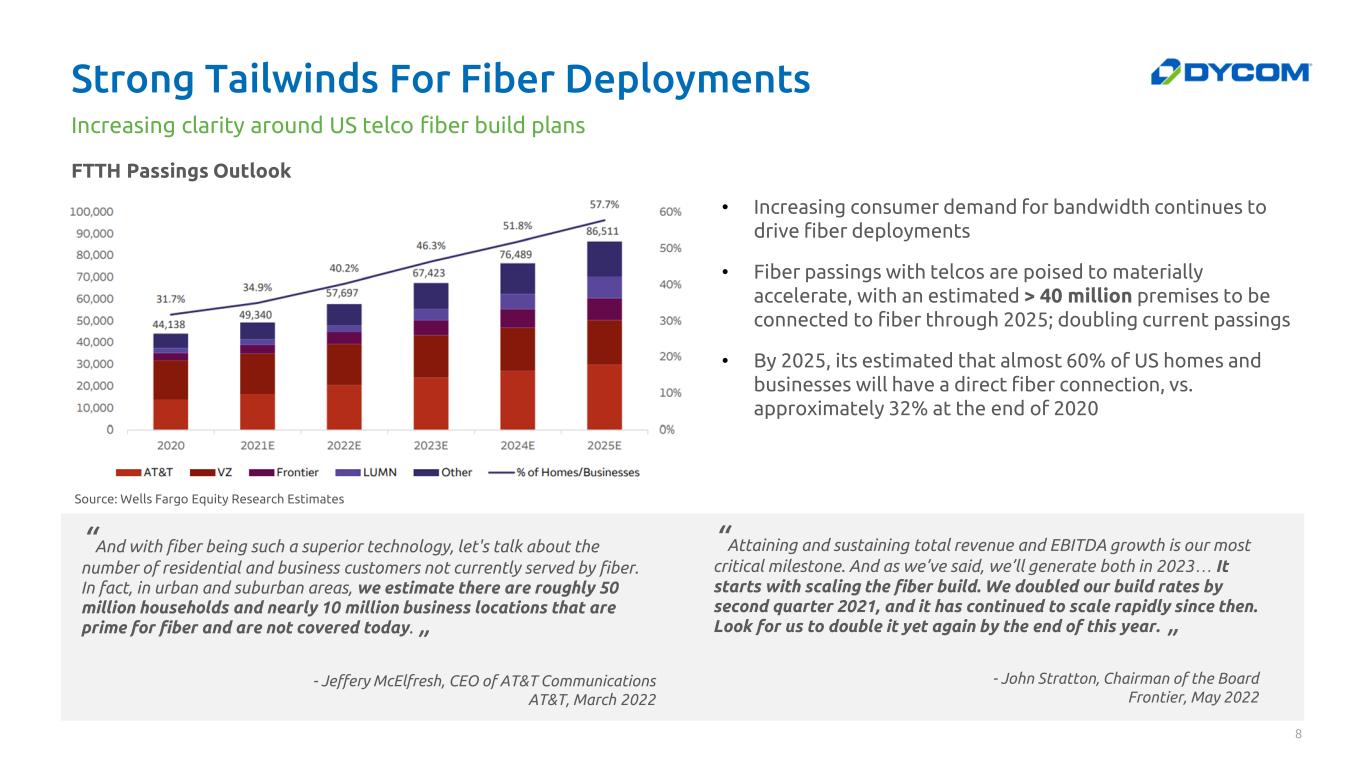
“Attaining and sustaining total revenue and EBITDA growth is our most critical milestone. And as we’ve said, we’ll generate both in 2023… It starts with scaling the fiber build. We doubled our build rates by second quarter 2021, and it has continued to scale rapidly since then. Look for us to double it yet again by the end of this year. ” Strong Tailwinds For Fiber Deployments 8 FTTH Passings Outlook • Increasing consumer demand for bandwidth continues to drive fiber deployments • Fiber passings with telcos are poised to materially accelerate, with an estimated > 40 million premises to be connected to fiber through 2025; doubling current passings • By 2025, its estimated that almost 60% of US homes and businesses will have a direct fiber connection, vs. approximately 32% at the end of 2020 Increasing clarity around US telco fiber build plans “And with fiber being such a superior technology, let's talk about the number of residential and business customers not currently served by fiber. In fact, in urban and suburban areas, we estimate there are roughly 50 million households and nearly 10 million business locations that are prime for fiber and are not covered today. ” - Jeffery McElfresh, CEO of AT&T Communications AT&T, March 2022 Source: Wells Fargo Equity Research Estimates - John Stratton, Chairman of the Board Frontier, May 2022
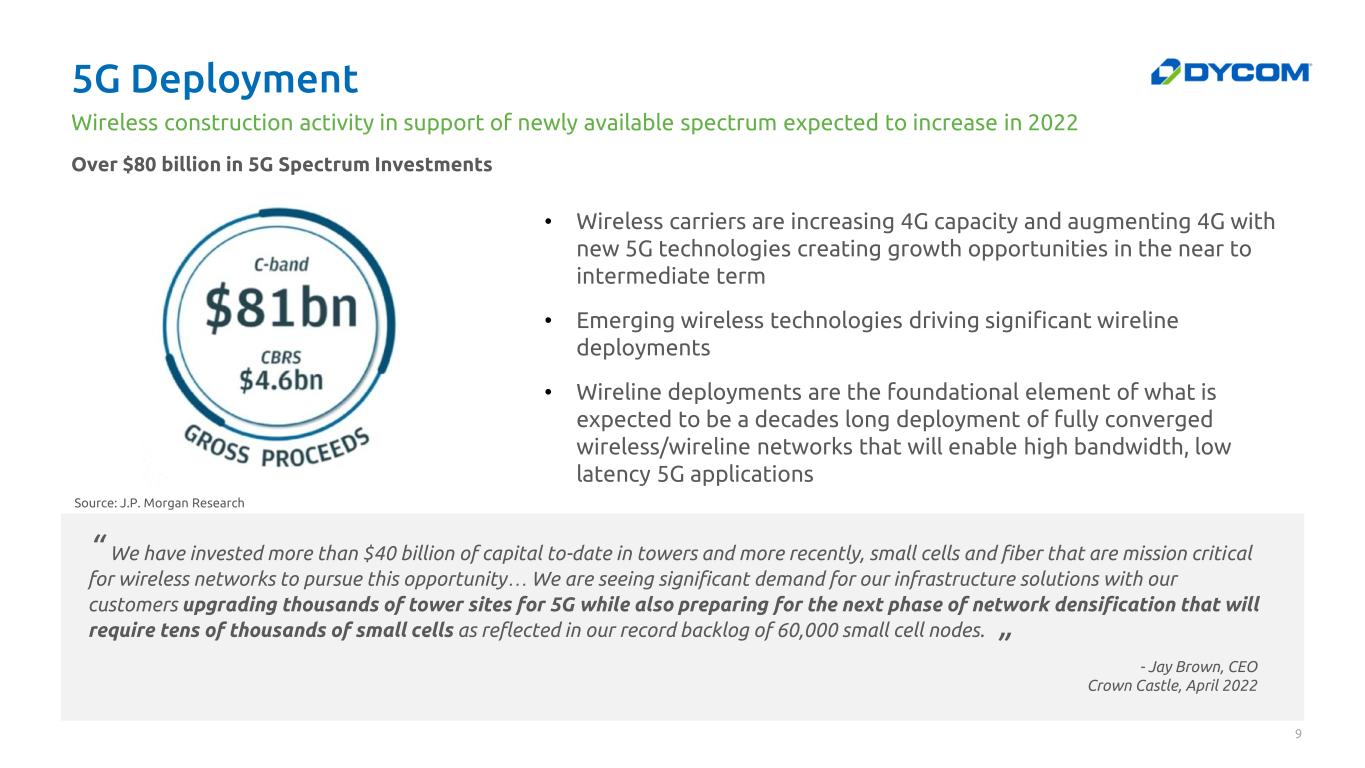
5G Deployment 9 Over $80 billion in 5G Spectrum Investments • Wireless carriers are increasing 4G capacity and augmenting 4G with new 5G technologies creating growth opportunities in the near to intermediate term • Emerging wireless technologies driving significant wireline deployments • Wireline deployments are the foundational element of what is expected to be a decades long deployment of fully converged wireless/wireline networks that will enable high bandwidth, low latency 5G applications Wireless construction activity in support of newly available spectrum expected to increase in 2022 “ We have invested more than $40 billion of capital to-date in towers and more recently, small cells and fiber that are mission critical for wireless networks to pursue this opportunity…We are seeing significant demand for our infrastructure solutions with our customers upgrading thousands of tower sites for 5G while also preparing for the next phase of network densification that will require tens of thousands of small cells as reflected in our record backlog of 60,000 small cell nodes. ” - Jay Brown, CEO Crown Castle, April 2022 Source: J.P. Morgan Research
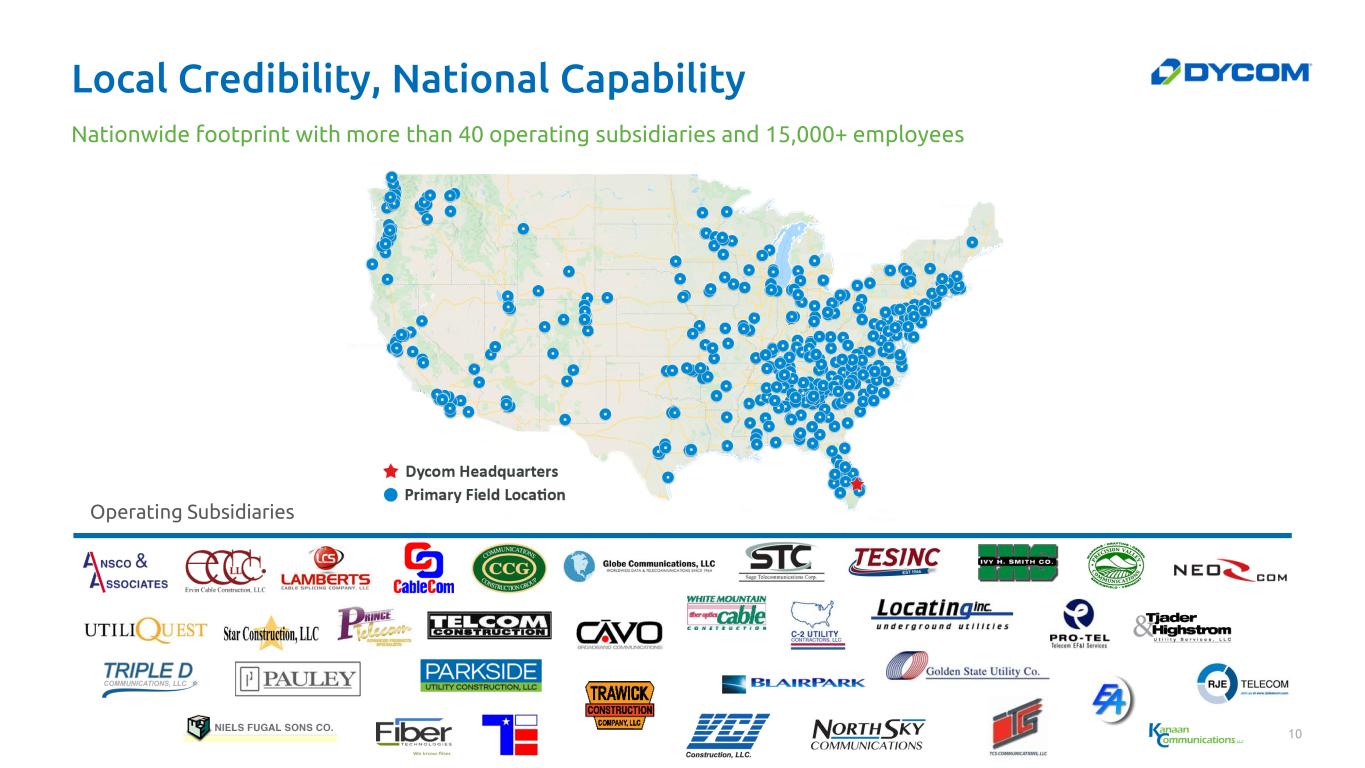
Local Credibility, National Capability Nationwide footprint with more than 40 operating subsidiaries and 15,000+ employees 10 Operating Subsidiaries
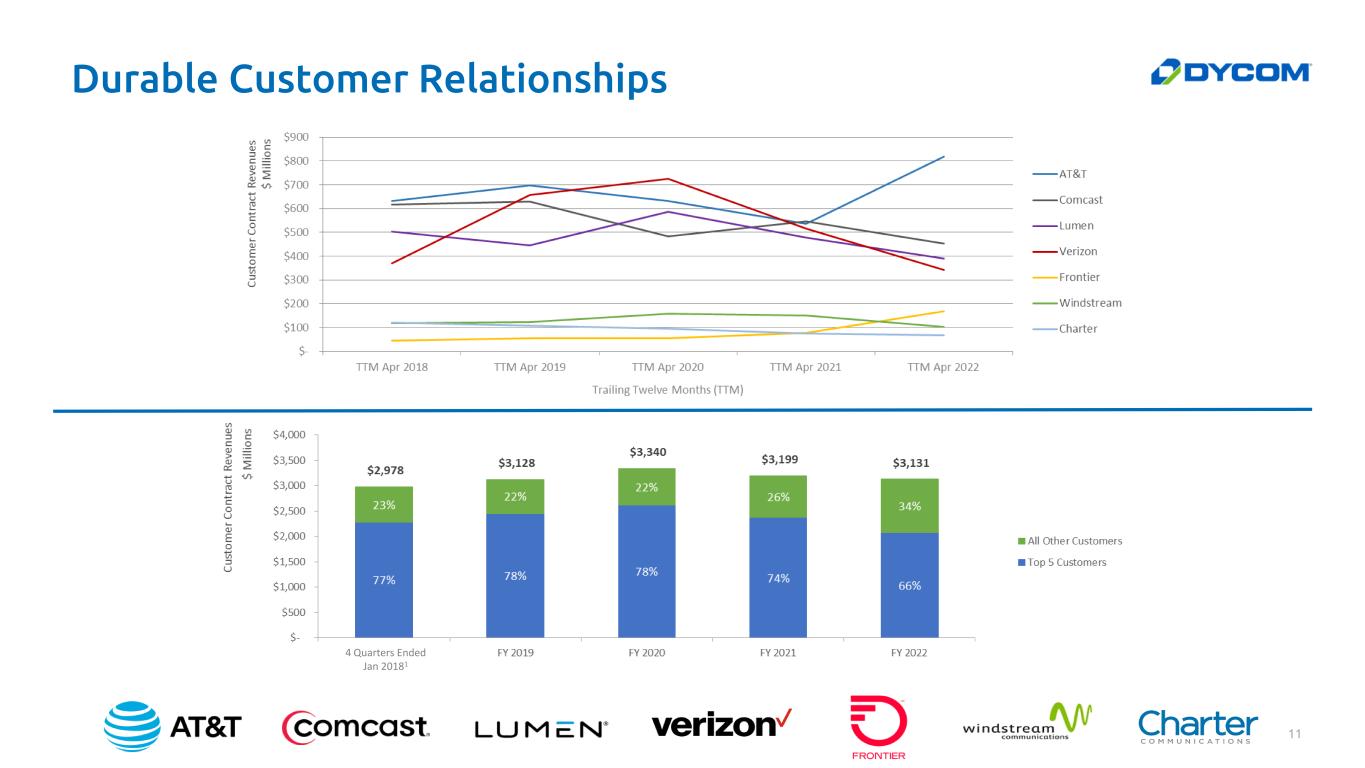
Durable Customer Relationships 11 4 Quarters Ended Jan 20181
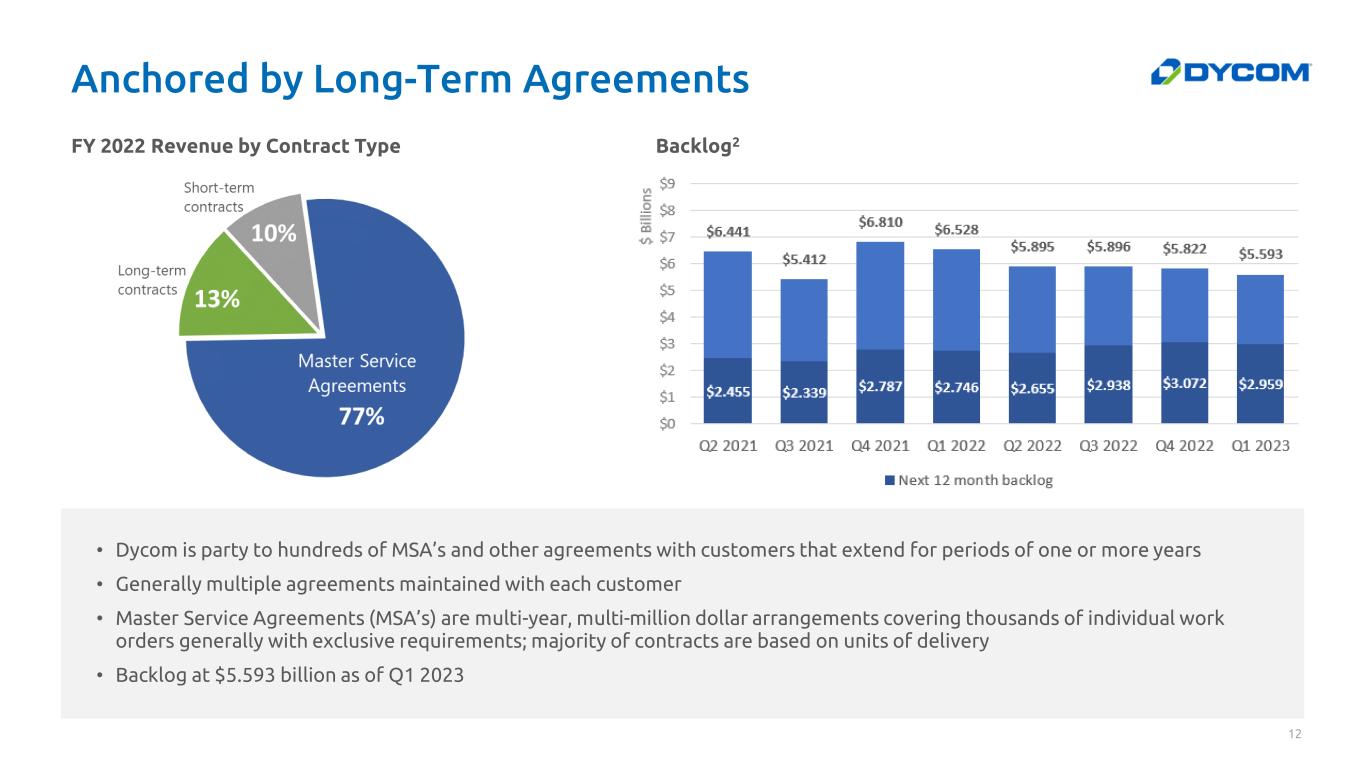
Anchored by Long-Term Agreements 12 FY 2022 Revenue by Contract Type Backlog2 • Dycom is party to hundreds of MSA’s and other agreements with customers that extend for periods of one or more years • Generally multiple agreements maintained with each customer • Master Service Agreements (MSA’s) are multi-year, multi-million dollar arrangements covering thousands of individual work orders generally with exclusive requirements; majority of contracts are based on units of delivery • Backlog at $5.593 billion as of Q1 2023
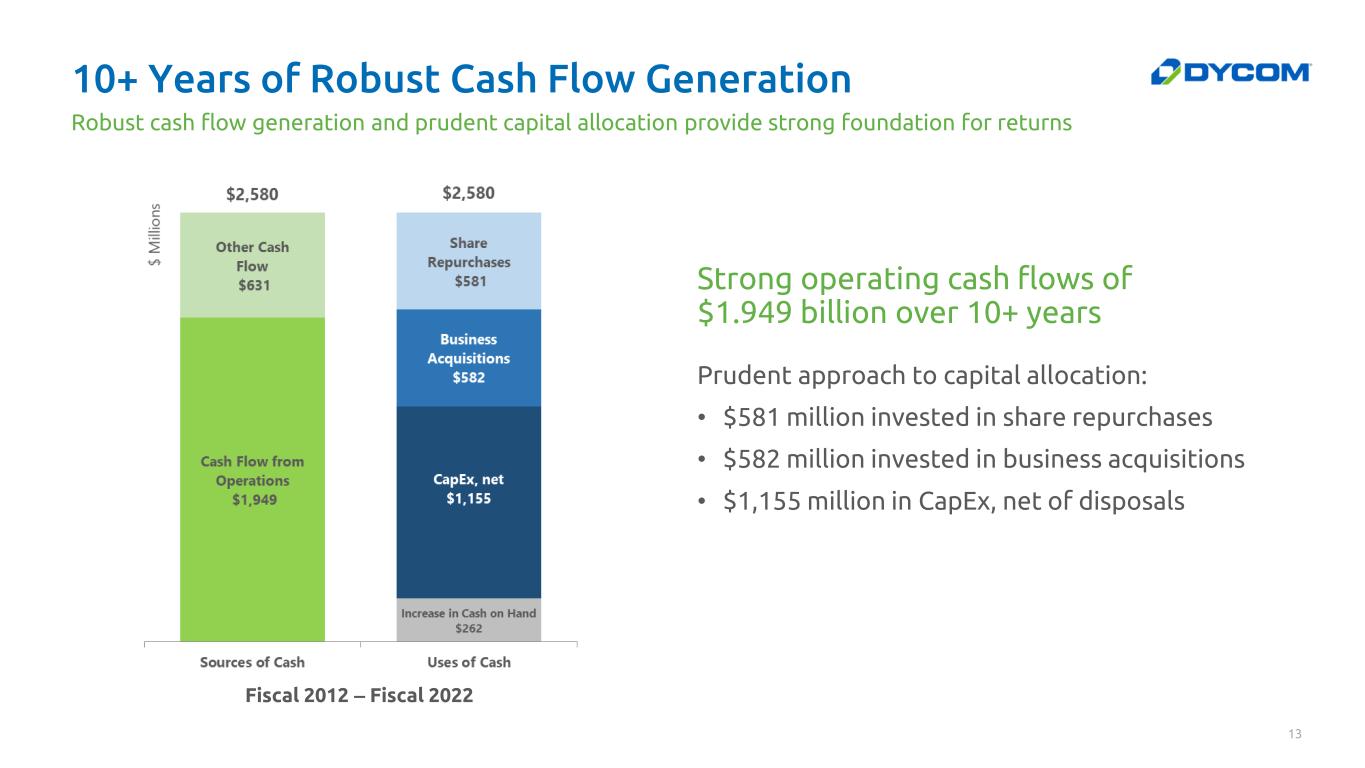
10+ Years of Robust Cash Flow Generation 13 Prudent approach to capital allocation: • $581 million invested in share repurchases • $582 million invested in business acquisitions • $1,155 million in CapEx, net of disposals Robust cash flow generation and prudent capital allocation provide strong foundation for returns Fiscal 2012 – Fiscal 2022 Strong operating cash flows of $1.949 billion over 10+ years
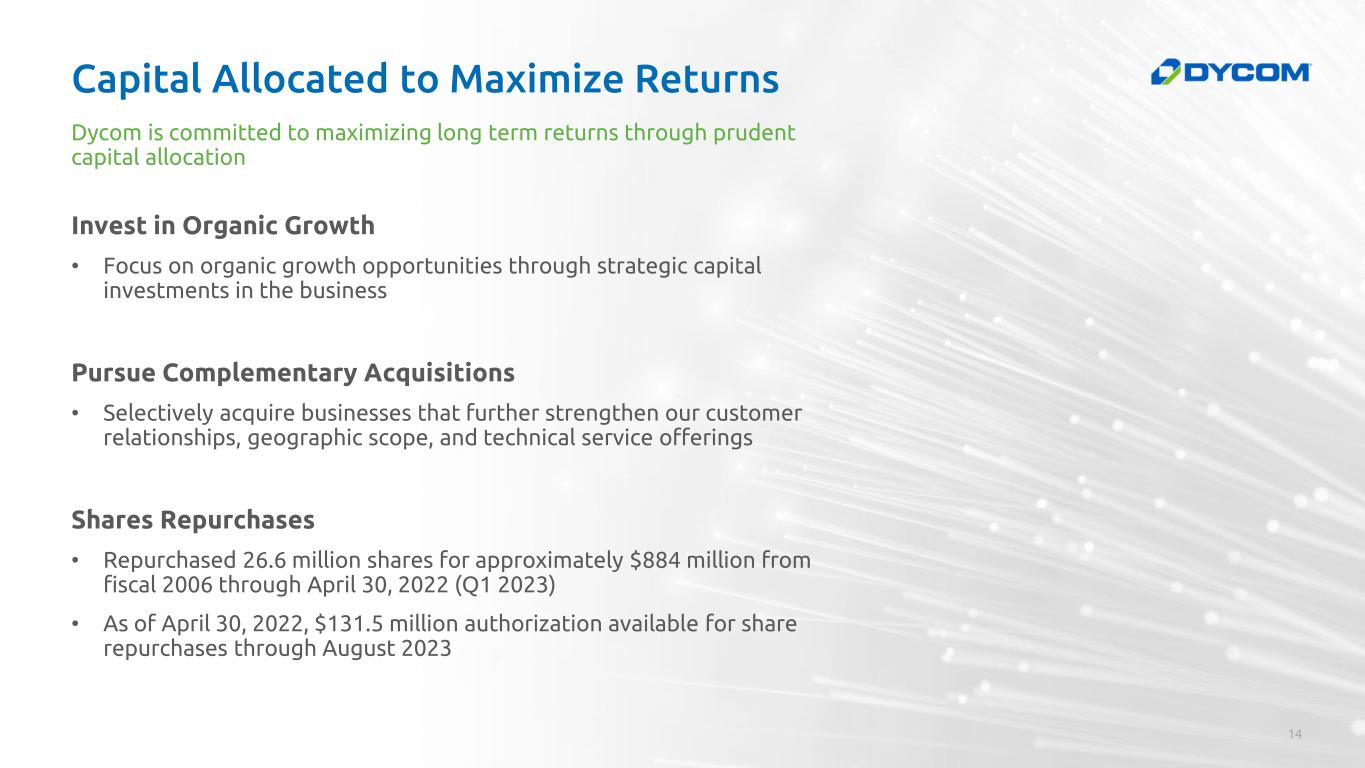
Capital Allocated to Maximize Returns Invest in Organic Growth • Focus on organic growth opportunities through strategic capital investments in the business Pursue Complementary Acquisitions • Selectively acquire businesses that further strengthen our customer relationships, geographic scope, and technical service offerings Shares Repurchases • Repurchased 26.6 million shares for approximately $884 million from fiscal 2006 through April 30, 2022 (Q1 2023) • As of April 30, 2022, $131.5 million authorization available for share repurchases through August 2023 14 Dycom is committed to maximizing long term returns through prudent capital allocation
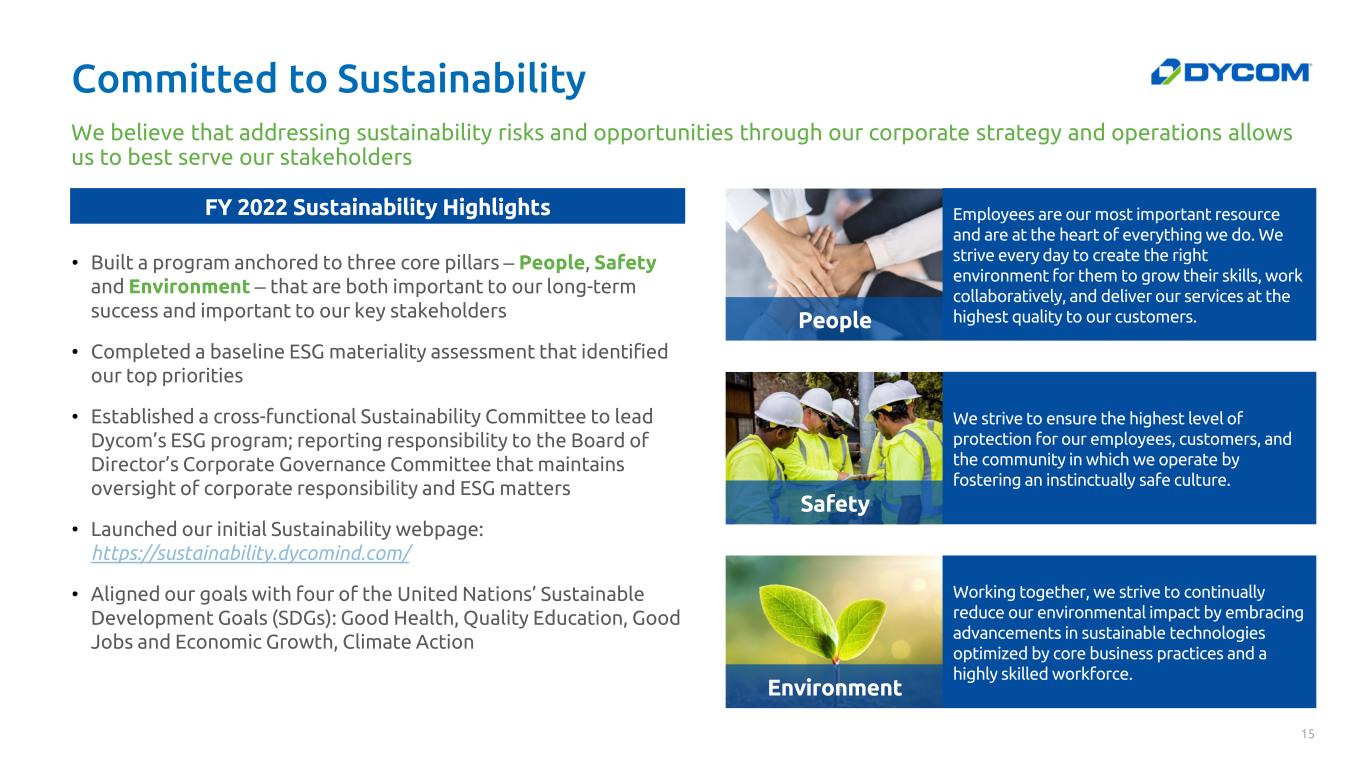
Working together, we strive to continually reduce our environmental impact by embracing advancements in sustainable technologies optimized by core business practices and a highly skilled workforce. Committed to Sustainability 15 • Built a program anchored to three core pillars – People, Safety and Environment – that are both important to our long-term success and important to our key stakeholders • Completed a baseline ESG materiality assessment that identified our top priorities • Established a cross-functional Sustainability Committee to lead Dycom’s ESG program; reporting responsibility to the Board of Director’s Corporate Governance Committee that maintains oversight of corporate responsibility and ESG matters • Launched our initial Sustainability webpage: https://sustainability.dycomind.com/ • Aligned our goals with four of the United Nations’ Sustainable Development Goals (SDGs): Good Health, Quality Education, Good Jobs and Economic Growth, Climate Action FY 2022 Sustainability Highlights People Safety Environment Employees are our most important resource and are at the heart of everything we do. We strive every day to create the right environment for them to grow their skills, work collaboratively, and deliver our services at the highest quality to our customers. We strive to ensure the highest level of protection for our employees, customers, and the community in which we operate by fostering an instinctually safe culture. We believe that addressing sustainability risks and opportunities through our corporate strategy and operations allows us to best serve our stakeholders

FINANCIAL UPDATE 16

Annual Trends 17 $2,978 $3,128 $3,340 $3,199 $3,131 4 Qtrs Ended Jan 2018 FY 2019 FY 2020 FY 2021 FY 2022 Contract Revenues $ M il li o n s $383 $330 $310 $311 $244 12.9% 10.5% 9.3% 9.7% 7.8% 4 Qtrs Ended Jan 2018 FY 2019 FY 2020 FY 2021 FY 2022 Non-GAAP Adjusted EBITDA Non-GAAP Adjusted EBITDA Non-GAAP Adjusted EBITDA % $ M il li o n s 1 1
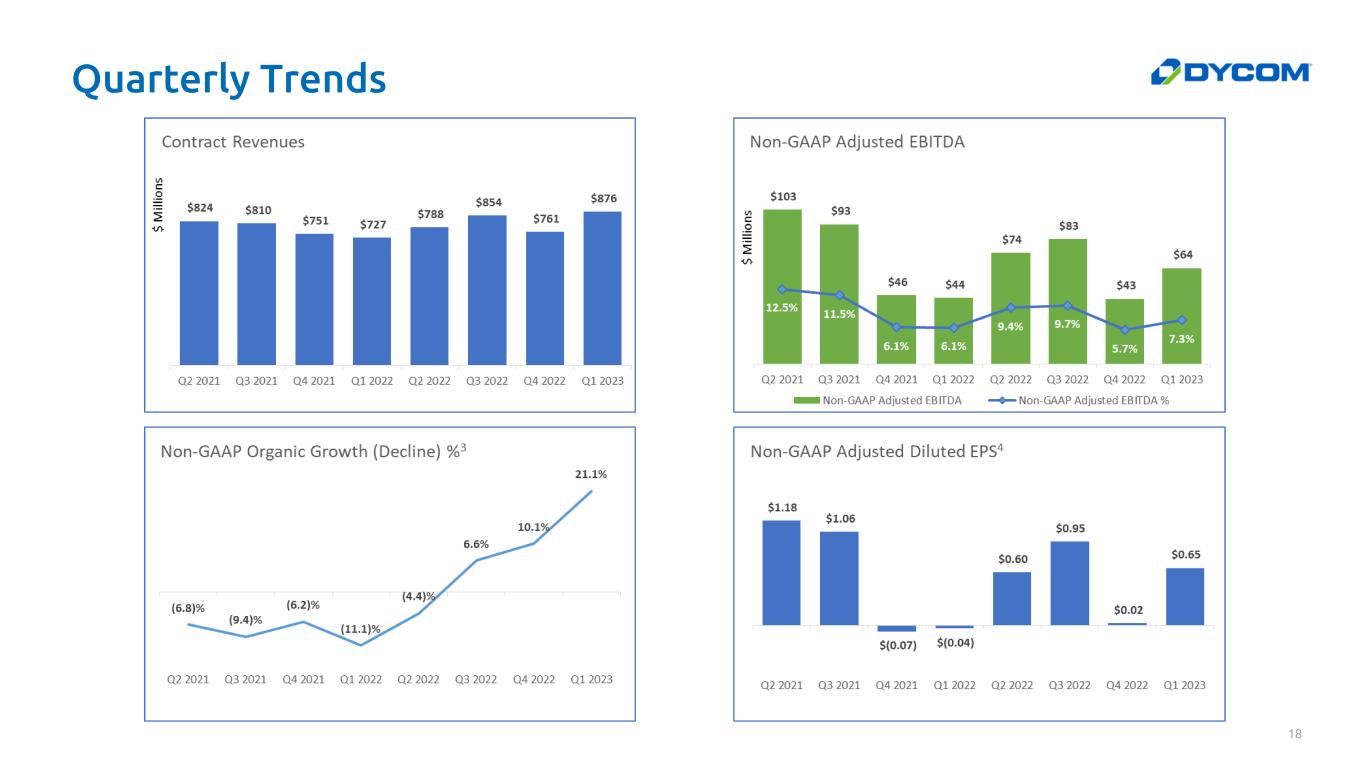
Quarterly Trends 18
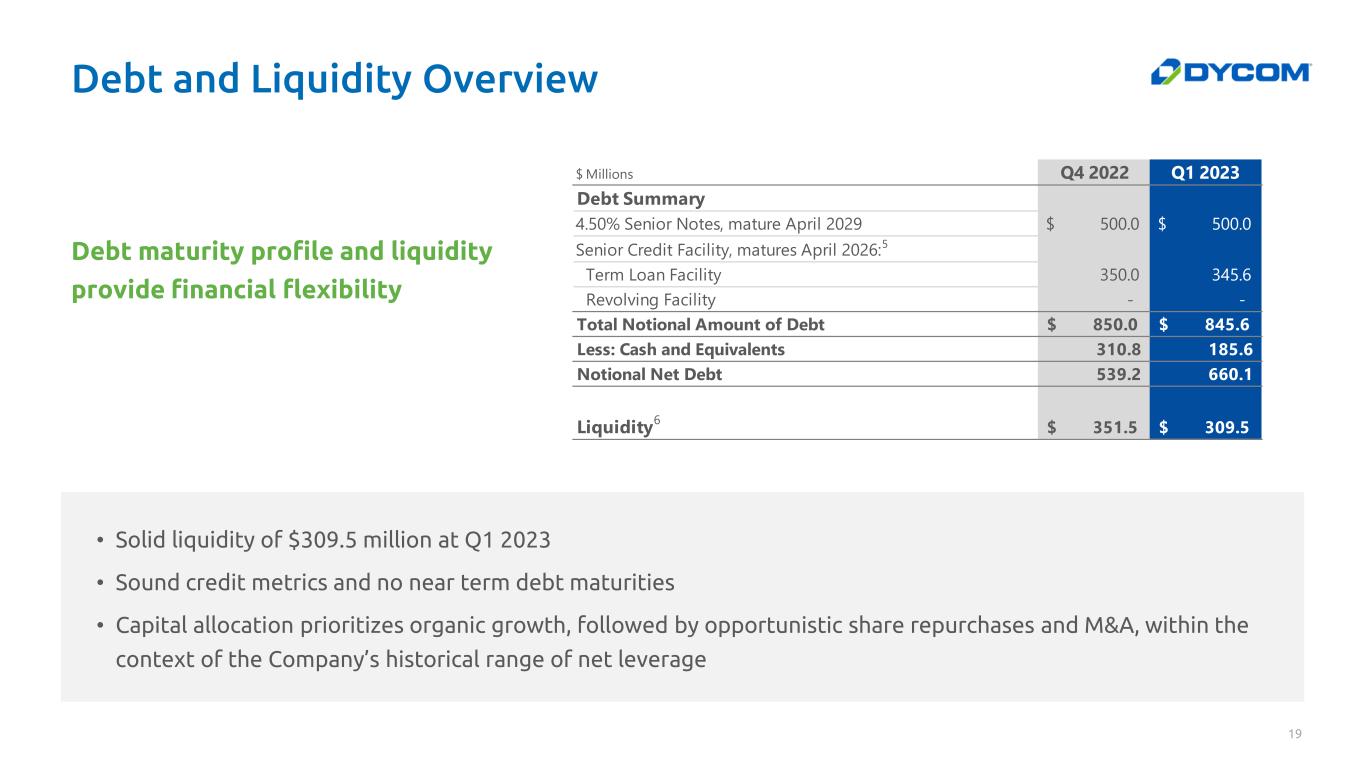
Debt and Liquidity Overview Debt maturity profile and liquidity provide financial flexibility 19 • Solid liquidity of $309.5 million at Q1 2023 • Sound credit metrics and no near term debt maturities • Capital allocation prioritizes organic growth, followed by opportunistic share repurchases and M&A, within the context of the Company’s historical range of net leverage $ Millions Q4 2022 Q1 2023 Debt Summary 4.50% Senior Notes, mature April 2029 $ 500.0 $ 500.0 Senior Credit Facility, matures April 2026:5 Term Loan Facility 350.0 345.6 Revolving Facility - - Total Notional Amount of Debt $ 850.0 $ 845.6 Less: Cash and Equivalents 310.8 185.6 Notional Net Debt 539.2 660.1 Liquidity 6 $ 351.5 $ 309.5
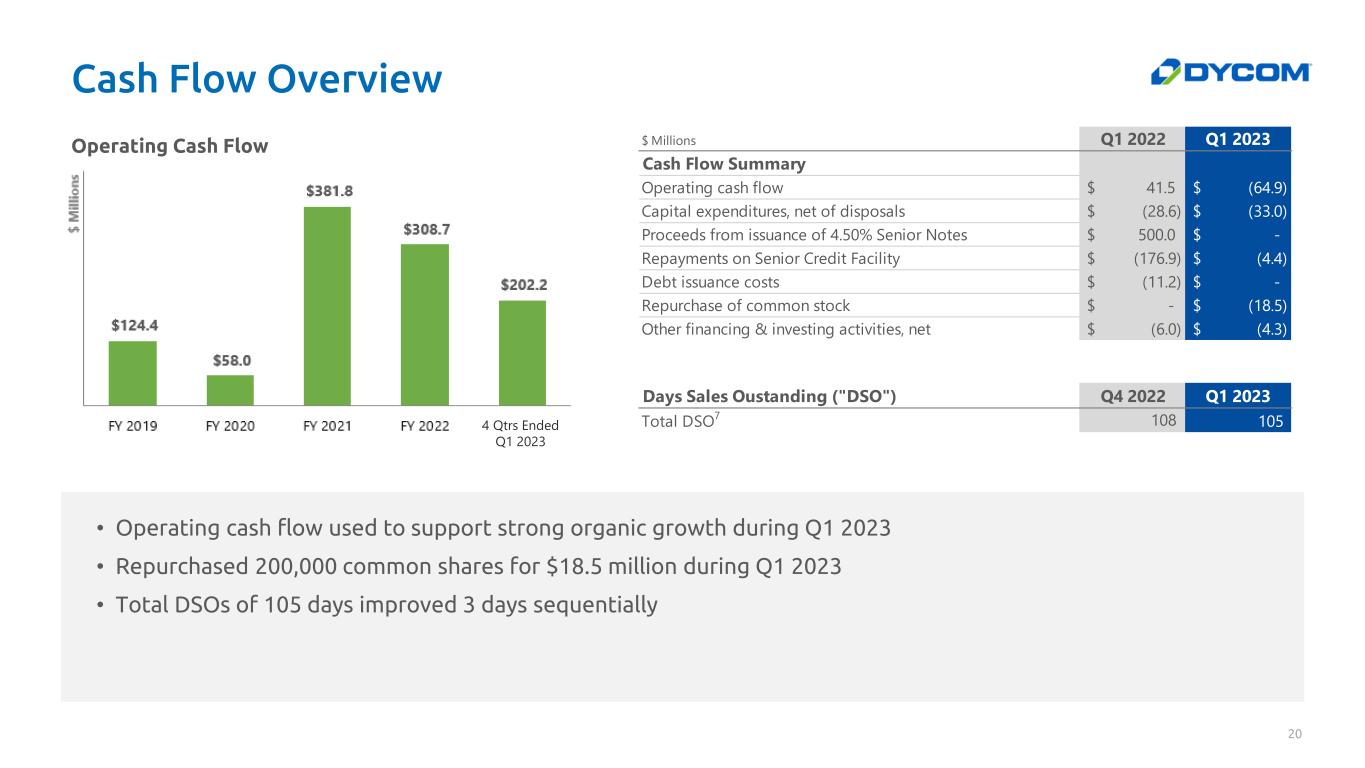
Cash Flow Overview 20 Operating Cash Flow • Operating cash flow used to support strong organic growth during Q1 2023 • Repurchased 200,000 common shares for $18.5 million during Q1 2023 • Total DSOs of 105 days improved 3 days sequentially 4 Qtrs Ended Q1 2023 $ Millions Q1 2022 Q1 2023 Cash Flow Summary Operating cash flow $ 41.5 $ (64.9) Capital expenditures, net of disposals $ (28.6) $ (33.0) Proceeds from issuance of 4.50% Senior Notes $ 500.0 $ - Repayments on Senior Credit Facility $ (176.9) $ (4.4) Debt issuance costs $ (11.2) $ - Repurchase of common stock $ - $ (18.5) Other financing & investing activities, net $ (6.0) $ (4.3) Days Sales Oustanding ("DSO") Q4 2022 Q1 2023 Total DSO7 108 105

QUESTIONS AND ANSWERS 21
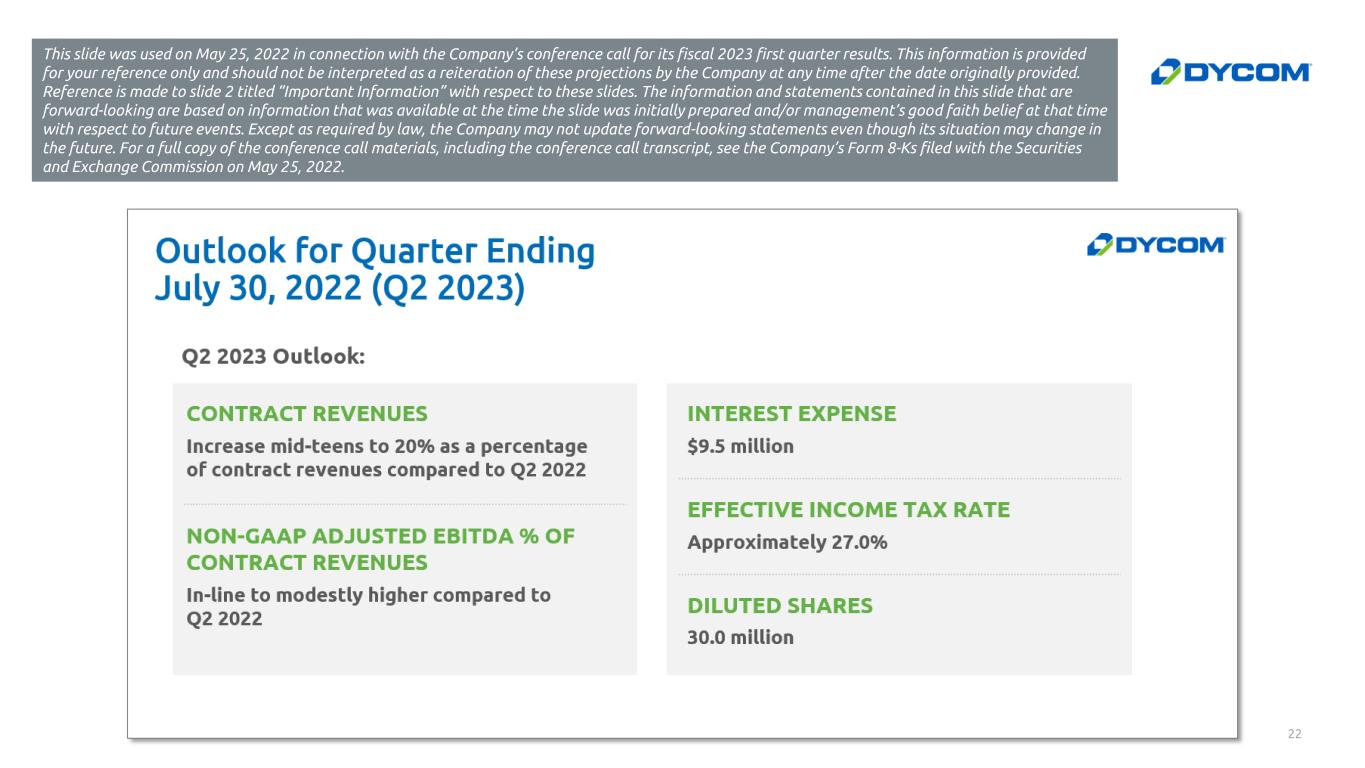
22 This slide was used on May 25, 2022 in connection with the Company’s conference call for its fiscal 2023 first quarter results. This information is provided for your reference only and should not be interpreted as a reiteration of these projections by the Company at any time after the date originally provided. Reference is made to slide 2 titled “Important Information” with respect to these slides. The information and statements contained in this slide that are forward-looking are based on information that was available at the time the slide was initially prepared and/or management’s good faith belief at that time with respect to future events. Except as required by law, the Company may not update forward-looking statements even though its situation may change in the future. For a full copy of the conference call materials, including the conference call transcript, see the Company’s Form 8-Ks filed with the Securities and Exchange Commission on May 25, 2022.
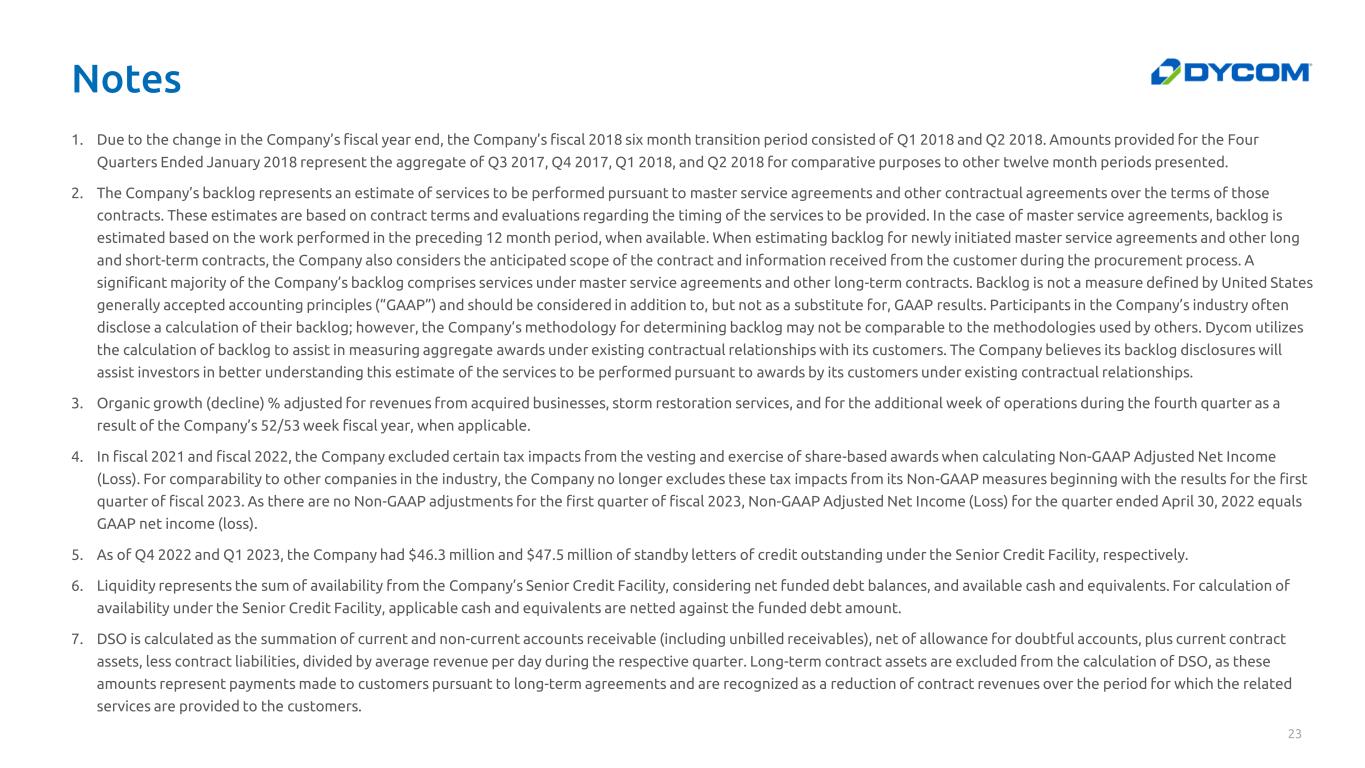
Notes 1. Due to the change in the Company’s fiscal year end, the Company’s fiscal 2018 six month transition period consisted of Q1 2018 and Q2 2018. Amounts provided for the Four Quarters Ended January 2018 represent the aggregate of Q3 2017, Q4 2017, Q1 2018, and Q2 2018 for comparative purposes to other twelve month periods presented. 2. The Company’s backlog represents an estimate of services to be performed pursuant to master service agreements and other contractual agreements over the terms of those contracts. These estimates are based on contract terms and evaluations regarding the timing of the services to be provided. In the case of master service agreements, backlog is estimated based on the work performed in the preceding 12 month period, when available. When estimating backlog for newly initiated master service agreements and other long and short-term contracts, the Company also considers the anticipated scope of the contract and information received from the customer during the procurement process. A significant majority of the Company’s backlog comprises services under master service agreements and other long-term contracts. Backlog is not a measure defined by United States generally accepted accounting principles (“GAAP”) and should be considered in addition to, but not as a substitute for, GAAP results. Participants in the Company’s industry often disclose a calculation of their backlog; however, the Company’s methodology for determining backlog may not be comparable to the methodologies used by others. Dycom utilizes the calculation of backlog to assist in measuring aggregate awards under existing contractual relationships with its customers. The Company believes its backlog disclosures will assist investors in better understanding this estimate of the services to be performed pursuant to awards by its customers under existing contractual relationships. 3. Organic growth (decline) % adjusted for revenues from acquired businesses, storm restoration services, and for the additional week of operations during the fourth quarter as a result of the Company’s 52/53 week fiscal year, when applicable. 4. In fiscal 2021 and fiscal 2022, the Company excluded certain tax impacts from the vesting and exercise of share-based awards when calculating Non-GAAP Adjusted Net Income (Loss). For comparability to other companies in the industry, the Company no longer excludes these tax impacts from its Non-GAAP measures beginning with the results for the first quarter of fiscal 2023. As there are no Non-GAAP adjustments for the first quarter of fiscal 2023, Non-GAAP Adjusted Net Income (Loss) for the quarter ended April 30, 2022 equals GAAP net income (loss). 5. As of Q4 2022 and Q1 2023, the Company had $46.3 million and $47.5 million of standby letters of credit outstanding under the Senior Credit Facility, respectively. 6. Liquidity represents the sum of availability from the Company’s Senior Credit Facility, considering net funded debt balances, and available cash and equivalents. For calculation of availability under the Senior Credit Facility, applicable cash and equivalents are netted against the funded debt amount. 7. DSO is calculated as the summation of current and non-current accounts receivable (including unbilled receivables), net of allowance for doubtful accounts, plus current contract assets, less contract liabilities, divided by average revenue per day during the respective quarter. Long-term contract assets are excluded from the calculation of DSO, as these amounts represent payments made to customers pursuant to long-term agreements and are recognized as a reduction of contract revenues over the period for which the related services are provided to the customers. 23
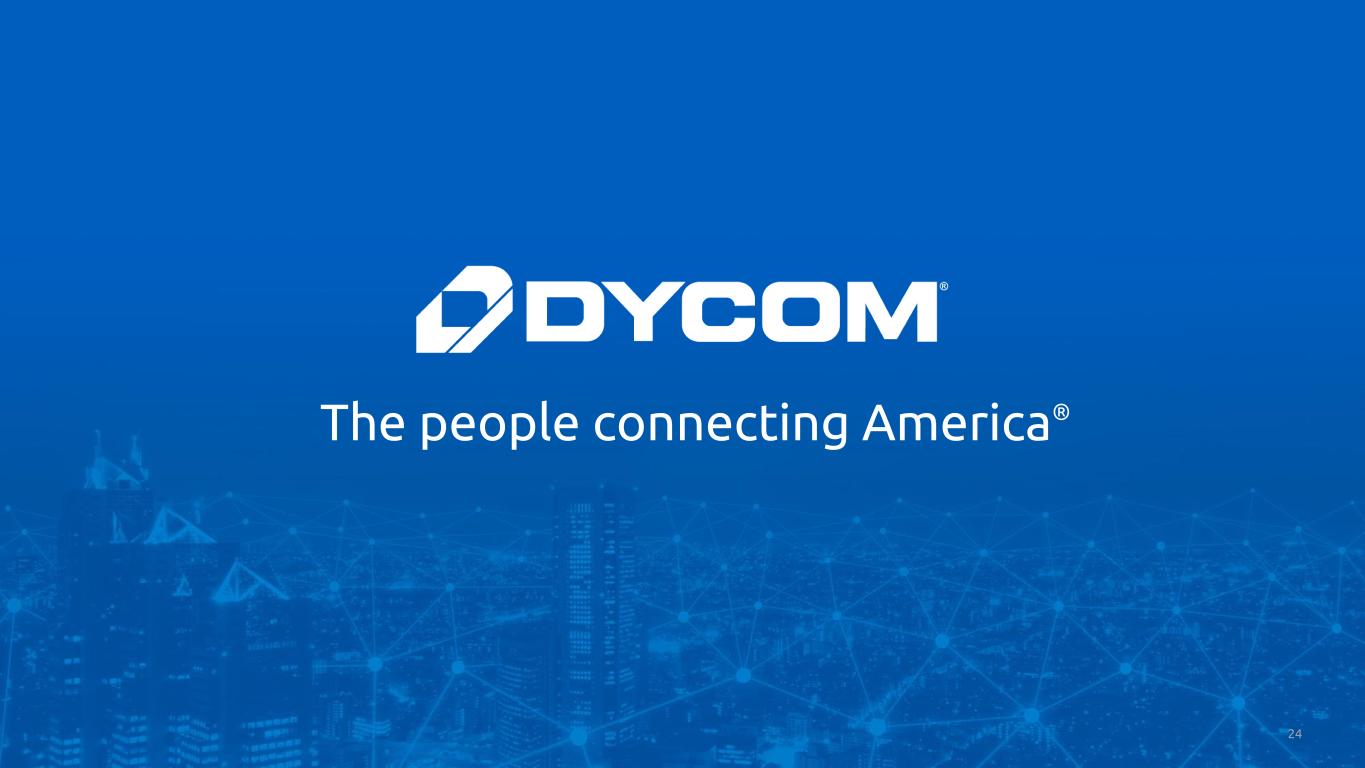
The people connecting America® 24
Exhibit 99.2
Dycom Industries, Inc.
Non-GAAP Reconciliations
Investor Presentation
June 2022
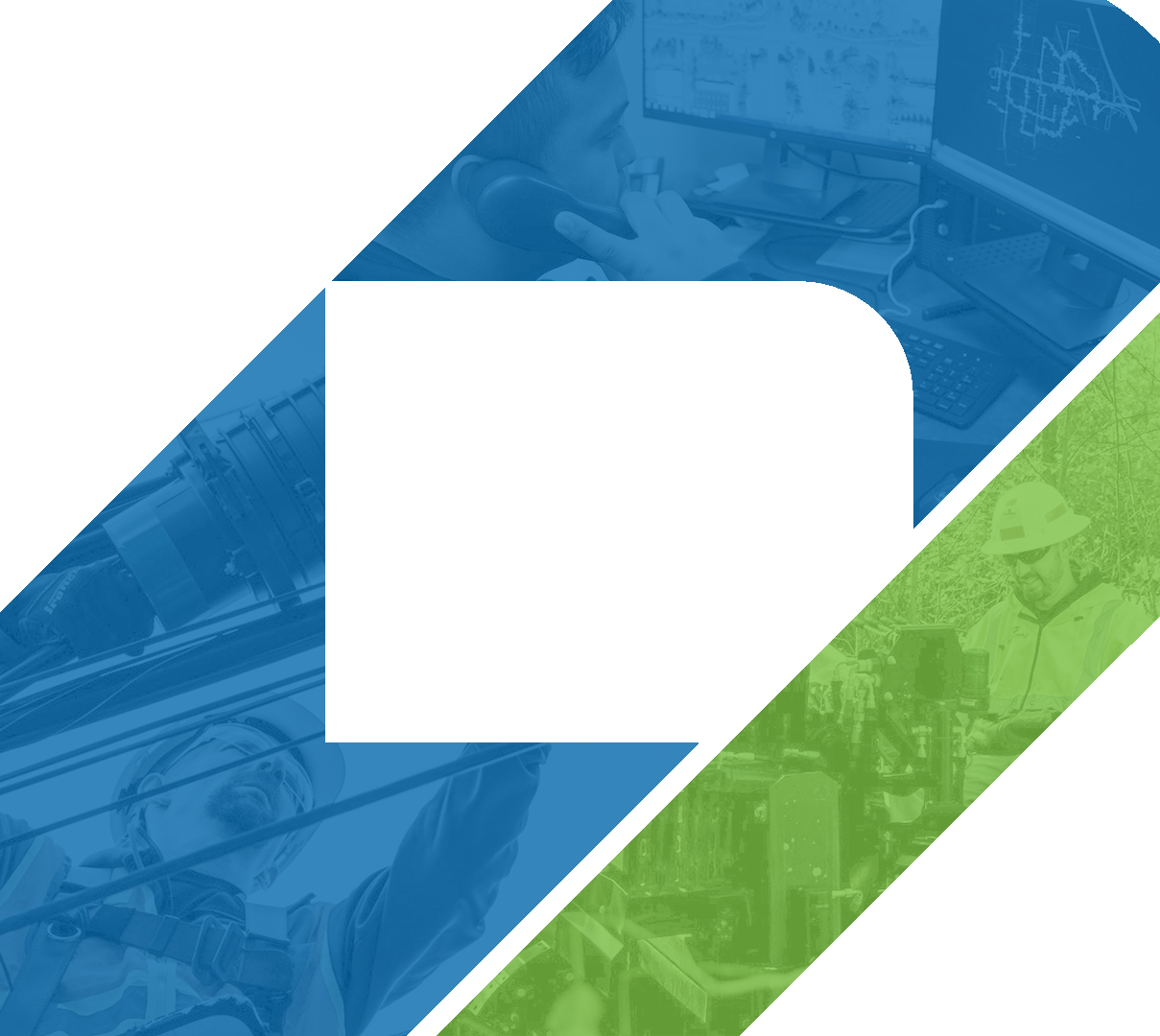

Explanation of Non-GAAP Financial Measures
The Company reports its financial results in accordance with U.S. generally accepted accounting principles (GAAP). In the Company’s quarterly results releases, trend schedules, conference calls, slide presentations, and webcasts, it may use or discuss Non-GAAP financial measures, as defined by Regulation G of the Securities and Exchange Commission. The Company believes that the presentation of certain Non-GAAP financial measures in these materials provides information that is useful to investors because it allows for a more direct comparison of the Company’s performance for the period reported with the Company’s performance in prior periods. The Company cautions that Non-GAAP financial measures should be considered in addition to, but not as a substitute for, the Company’s reported GAAP results. Management defines the Non-GAAP financial measures used as follows:
•Non-GAAP Organic Contract Revenues - contract revenues from businesses that are included for the entire period in both the current and prior year periods, excluding contract revenues from storm restoration services, adjusted for the additional week in the fourth quarter of fiscal 2021, as a result of the Company’s 52/53 week fiscal year. Non-GAAP Organic Contract Revenue change percentage is calculated as the change in Non-GAAP Organic Contract Revenues from the comparable prior year period divided by the comparable prior year period Non-GAAP Organic Contract Revenues. Management believes Non-GAAP Organic Contract Revenues is a helpful measure for comparing the Company’s revenue performance with prior periods.
•Non-GAAP Adjusted EBITDA - net income (loss) before interest, taxes, depreciation and amortization, gain (loss) on sale of fixed assets, stock-based compensation expense, and certain non-recurring items. Management believes Non-GAAP Adjusted EBITDA is a helpful measure for comparing the Company’s operating performance with prior periods as well as with the performance of other companies with different capital structures or tax rates.
•Non-GAAP Adjusted Net Income (Loss) - GAAP net income (loss) before the non-cash amortization of the debt discount and the related tax impact, certain tax impacts resulting from vesting and exercise of share-based awards, and certain non-recurring items. Management believes Non-GAAP Adjusted Net Income (Loss) is a helpful measure for comparing the Company’s operating performance with prior periods.
•Non-GAAP Adjusted Diluted Earnings (Loss) per Common Share and Non-GAAP Adjusted Diluted Shares - Non-GAAP Adjusted Net Income (Loss) divided by Non-GAAP Adjusted Diluted Shares outstanding. Non-GAAP Adjusted Diluted Shares used in the computation of Non-GAAP Adjusted Diluted Earnings (Loss) per Common Share is adjusted for common stock equivalents related to share-based awards in where their effect would be anti-dilutive.
•Notional Net Debt - Notional net debt is a Non-GAAP financial measure that is calculated by subtracting cash and equivalents from the aggregate face amount of outstanding debt. Management believes notional net debt is a helpful measure to assess the Company’s liquidity.
Management excludes or adjusts each of the items identified below from Non-GAAP Adjusted Net Income (Loss) and Non-GAAP Adjusted Diluted Earnings (Loss) per Common Share:
•Non-cash amortization of debt discount on 2021 Convertible Notes - The Company’s 0.75% convertible senior notes due September 2021 (the “2021 Convertible Notes”) were allocated between debt and equity components. The difference between the principal amount and the carrying amount of the liability component of the 2021 Convertible Notes represents a debt discount. The debt discount was amortized over the term of the 2021 Convertible Notes but did not result in periodic cash interest payments. The Company excludes the non-cash amortization of the debt discount from its Non-GAAP financial measures because it believes it is useful to analyze the component of interest expense for the 2021 Convertible Notes that would be paid in cash. The exclusion of the non-cash amortization from the Company’s Non-GAAP financial measures provides management with a consistent measure for assessing financial results.
•Charges for a wage and hour litigation settlement - During the fourth quarter of fiscal 2021, the Company incurred a $2.3 million pre-tax charge for a wage and hour litigation settlement. The Company excludes the impact of this charge from its Non-GAAP financial measures because the Company believes it is not indicative of its underlying results in the current period.
•Goodwill impairment charge - During the first quarter of fiscal 2021, the Company incurred a goodwill impairment charge of $53.3 million for a reporting unit that performs installation services inside third party premises. Management believes excluding the goodwill impairment charge from the Company’s Non-GAAP financial measures assists investors’ overall understanding of the Company’s current financial performance and provides management with a consistent measure for assessing the current and historical financial results.
2

•Loss (gain) on debt extinguishment - During the first quarter of fiscal 2022, the Company recognized a loss on debt extinguishment of $0.1 million in connection with the amendment and restatement of its credit agreement. During fiscal 2021, the Company recognized a gain on debt extinguishment of $12.0 million in connection with its purchase of $401.7 million aggregate principal amount of the Company’s 2021 Convertible Notes for $371.4 million, including interest and fees and, during fiscal 2020, the Company incurred a loss on debt extinguishment of $0.1 million in connection with the purchase of $25.0 million aggregate principal amount of 2021 Convertible Notes for $24.3 million, including interest and fees. Management believes excluding the loss (gain) on debt extinguishment from the Company’s Non-GAAP financial measures assists investors’ overall understanding of the Company’s current financial performance and provides management with a consistent measure for assessing the current and historical financial results.
•Charge for warranty costs - During the first quarter of fiscal 2020, the Company recorded an $8.2 million pre-tax charge for estimated warranty costs for work performed for a customer in prior periods. The Company excludes the impact of this charge from its Non-GAAP financial measures because the Company believes it is not indicative of its underlying results in the current period.
•Charge for (recovery of) previously reserved accounts receivable and contract assets - During the fourth quarter of fiscal 2019, the Company recognized a pre-tax non-cash charge for accounts receivable and contract assets of $17.2 million related to balances owed from a customer. On February 25, 2019, this customer filed a voluntary petition for reorganization. During the first quarter of fiscal 2020, the Company recognized $10.3 million of pre-tax income from the recovery of previously reserved accounts receivable and contract assets based on collections from a customer. The Company excludes the impact of this recovery from its Non-GAAP financial measures because the Company believes it is not indicative of its underlying results.
•Tax impact of the vesting and exercise of share-based awards - In fiscal 2021 and fiscal 2022, the Company excluded certain tax impacts resulting from the vesting and exercise of share-based awards. For comparability to other companies in the industry, the Company no longer excludes these tax impacts from its Non-GAAP measures beginning with the results for the first quarter of fiscal 2023.
•Tax impact of pre-tax adjustments - The tax impact of pre-tax adjustments reflects the Company’s estimated tax impact of specific adjustments and the effective tax rate used for financial planning for the applicable period.
3

| Reconciliation of Non-GAAP Financial Measures to Comparable GAAP Financial Measures | ||||||||||||||||||||||||||||||||||||||
| Quarterly Non-GAAP Organic Contract Revenues | ||||||||||||||||||||||||||||||||||||||
| Unaudited | ||||||||||||||||||||||||||||||||||||||
| (Dollars in millions) | ||||||||||||||||||||||||||||||||||||||
| Contract Revenues - GAAP | Revenues from storm restoration services | Additional week as a result of the Company’s 52/53 week fiscal year1 | Non-GAAP - Organic Revenues | Growth (Decline)% | ||||||||||||||||||||||||||||||||||
| Quarter Ended | GAAP - Organic % | Non-GAAP - Organic % | ||||||||||||||||||||||||||||||||||||
| April 30, 2022 (Q1 2023) | $ | 876.3 | $ | — | $ | — | $ | 876.3 | 20.5 | % | 21.1 | % | ||||||||||||||||||||||||||
| May 1, 2021 (Q1 2022) | $ | 727.5 | $ | (3.9) | $ | — | $ | 723.6 | ||||||||||||||||||||||||||||||
| January 29, 2022 (Q4 2022) | $ | 761.5 | $ | — | $ | — | $ | 761.5 | 1.4 | % | 10.1 | % | ||||||||||||||||||||||||||
| January 30, 2021 (Q4 2021) | $ | 750.7 | $ | (5.7) | $ | (53.2) | $ | 691.8 | ||||||||||||||||||||||||||||||
| October 30, 2021 (Q3 2022) | $ | 854.0 | $ | — | $ | — | $ | 854.0 | 5.4 | % | 6.6 | % | ||||||||||||||||||||||||||
| October 24, 2020 (Q3 2021) | $ | 810.3 | $ | (8.9) | $ | — | $ | 801.4 | ||||||||||||||||||||||||||||||
| July 31, 2021 (Q2 2022) | $ | 787.6 | $ | — | $ | — | $ | 787.6 | (4.4) | % | (4.4) | % | ||||||||||||||||||||||||||
| July 25, 2020 (Q2 2021) | $ | 823.9 | $ | — | $ | — | $ | 823.9 | ||||||||||||||||||||||||||||||
| May 1, 2021 (Q1 2022) | $ | 727.5 | $ | (3.9) | $ | — | $ | 723.6 | (10.7) | % | (11.1) | % | ||||||||||||||||||||||||||
| April 25, 2020 (Q1 2021) | $ | 814.3 | $ | — | $ | — | $ | 814.3 | ||||||||||||||||||||||||||||||
| January 30, 2021 (Q4 2021) | $ | 750.7 | $ | (5.7) | $ | (53.2) | $ | 691.8 | 1.8 | % | (6.2) | % | ||||||||||||||||||||||||||
| January 25, 2020 (Q4 2020) | $ | 737.6 | $ | — | $ | — | $ | 737.6 | ||||||||||||||||||||||||||||||
| October 24, 2020 (Q3 2021) | $ | 810.3 | $ | (8.9) | $ | — | $ | 801.4 | (8.4) | % | (9.4) | % | ||||||||||||||||||||||||||
| October 26, 2019 (Q3 2020) | $ | 884.1 | $ | — | $ | — | $ | 884.1 | ||||||||||||||||||||||||||||||
| July 25, 2020 (Q2 2021) | $ | 823.9 | $ | — | $ | — | $ | 823.9 | (6.8) | % | (6.8) | % | ||||||||||||||||||||||||||
| July 27, 2019 (Q2 2020) | $ | 884.2 | $ | — | $ | — | $ | 884.2 | ||||||||||||||||||||||||||||||
Note: Amounts above may not add due to rounding.
4

| Reconciliation of Non-GAAP Financial Measures to Comparable GAAP Financial Measures | |||||||||||||||||||||||||||||||||||||||||||||||
| Quarterly Non-GAAP Adjusted EBITDA | |||||||||||||||||||||||||||||||||||||||||||||||
| Unaudited | |||||||||||||||||||||||||||||||||||||||||||||||
| (Dollars in millions) | |||||||||||||||||||||||||||||||||||||||||||||||
| Q2-21 | Q3-21 | Q4-21 | Q1-22 | Q2-22 | Q3-22 | Q4-22 | Q1-23 | ||||||||||||||||||||||||||||||||||||||||
| Ended | Ended | Ended | Ended | Ended | Ended | Ended | Ended | ||||||||||||||||||||||||||||||||||||||||
| 7/25/20 | 10/24/20 | 1/30/21 | 5/1/21 | 7/31/21 | 10/30/21 | 1/29/22 | 4/30/22 | ||||||||||||||||||||||||||||||||||||||||
| Net income (loss) | $ | 37.0 | $ | 33.9 | $ | (4.2) | $ | 0.9 | $ | 18.2 | $ | 28.7 | $ | 0.8 | $ | 19.5 | |||||||||||||||||||||||||||||||
| Interest expense, net | 7.9 | 4.7 | 4.7 | 5.9 | 9.3 | 9.1 | 8.8 | 9.1 | |||||||||||||||||||||||||||||||||||||||
| Provision (benefit) for income taxes | 12.2 | 12.0 | (2.1) | (2.7) | 6.5 | 6.2 | (5.7) | 0.7 | |||||||||||||||||||||||||||||||||||||||
| Depreciation and amortization | 44.1 | 42.3 | 43.6 | 39.1 | 38.5 | 37.8 | 37.3 | 36.6 | |||||||||||||||||||||||||||||||||||||||
| Earnings Before Interest, Taxes, Depreciation & Amortization (“EBITDA”) | 101.3 | 93.0 | 42.0 | 43.1 | 72.5 | 81.8 | 41.2 | 66.0 | |||||||||||||||||||||||||||||||||||||||
| (Gain) loss on sale of fixed assets | (3.4) | (4.0) | (0.8) | (2.9) | (1.0) | (0.4) | 0.1 | (5.4) | |||||||||||||||||||||||||||||||||||||||
| Stock-based compensation expense | 4.4 | 3.8 | 2.3 | 3.7 | 2.3 | 1.8 | 2.0 | 3.1 | |||||||||||||||||||||||||||||||||||||||
Loss on debt extinguishment2,3 | 0.5 | — | — | 0.1 | — | — | — | — | |||||||||||||||||||||||||||||||||||||||
Charges for a wage and hour litigation settlement4 | — | — | 2.3 | — | — | — | — | — | |||||||||||||||||||||||||||||||||||||||
| Non-GAAP Adjusted EBITDA | $ | 102.7 | $ | 92.8 | $ | 45.7 | $ | 44.1 | $ | 73.8 | $ | 83.1 | $ | 43.3 | $ | 63.7 | |||||||||||||||||||||||||||||||
| Contract revenues | $ | 823.9 | $ | 810.3 | $ | 750.7 | $ | 727.5 | $ | 787.6 | $ | 854.0 | $ | 761.5 | $ | 876.3 | |||||||||||||||||||||||||||||||
| Non-GAAP Adjusted EBITDA % of contract revenues | 12.5 | % | 11.5 | % | 6.1 | % | 6.1 | % | 9.4 | % | 9.7 | % | 5.7 | % | 7.3 | % | |||||||||||||||||||||||||||||||
Note: Amounts above may not add due to rounding.
5

| Reconciliation of Non-GAAP Financial Measures to Comparable GAAP Financial Measures | |||||||||||||||||||||||||||||
| Annual Non-GAAP Adjusted EBITDA | |||||||||||||||||||||||||||||
| Unaudited | |||||||||||||||||||||||||||||
| (Dollars in millions) | |||||||||||||||||||||||||||||
| 4 Qtrs. | FY2019 | FY2020 | FY2021 | FY2022 | |||||||||||||||||||||||||
| Ended | Ended | Ended | Ended | Ended | |||||||||||||||||||||||||
1/27/189 | 1/26/19 | 1/25/20 | 1/30/21 | 1/29/22 | |||||||||||||||||||||||||
| Net income | $ | 151.3 | $ | 62.9 | $ | 57.2 | $ | 34.3 | $ | 48.6 | |||||||||||||||||||
| Interest expense, net | 38.7 | 44.4 | 50.9 | 29.7 | 33.2 | ||||||||||||||||||||||||
| Provision for income taxes | 26.6 | 25.1 | 21.3 | 24.9 | 4.2 | ||||||||||||||||||||||||
| Depreciation and amortization | 162.7 | 179.6 | 187.6 | 175.9 | 152.7 | ||||||||||||||||||||||||
| Earnings Before Interest, Taxes, Depreciation & Amortization (“EBITDA”) | 379.3 | 312.0 | 317.0 | 264.8 | 238.6 | ||||||||||||||||||||||||
| Gain on sale of fixed assets | (18.9) | (19.4) | (14.9) | (10.0) | (4.2) | ||||||||||||||||||||||||
| Stock-based compensation expense | 23.1 | 20.2 | 10.0 | 12.8 | 9.9 | ||||||||||||||||||||||||
Loss (gain) on debt extinguishment2,3,5 | — | — | 0.1 | (12.0) | 0.1 | ||||||||||||||||||||||||
Charges for a wage and hour litigation settlement4 | — | — | — | 2.3 | — | ||||||||||||||||||||||||
Goodwill impairment charge6 | — | — | — | 53.3 | — | ||||||||||||||||||||||||
Charge for warranty costs7 | — | — | 8.2 | — | — | ||||||||||||||||||||||||
Charge for (recovery of) accounts receivable and contract assets8 | — | 17.2 | (10.3) | — | — | ||||||||||||||||||||||||
| Non-GAAP Adjusted EBITDA | $ | 383.5 | $ | 330.0 | $ | 310.0 | $ | 311.0 | $ | 244.3 | |||||||||||||||||||
| Contract revenues | $ | 2,977.9 | $ | 3,127.7 | $ | 3,339.7 | $ | 3,199.2 | $ | 3,130.5 | |||||||||||||||||||
| Non-GAAP Adjusted EBITDA % of contract revenues | 12.9 | % | 10.5 | % | 9.3 | % | 9.7 | % | 7.8 | % | |||||||||||||||||||
Note: Amounts above may not add due to rounding.
6

| Reconciliation of Non-GAAP Financial Measures to Comparable GAAP Financial Measures | |||||||||||||||||||||||||||||||||||||||||||||||
| Quarterly Non-GAAP Adjusted Net Income (Loss), Non-GAAP Adjusted Diluted Earnings (Loss) Per Common Share, and Non-GAAP Adjusted Diluted Shares | |||||||||||||||||||||||||||||||||||||||||||||||
| Unaudited | |||||||||||||||||||||||||||||||||||||||||||||||
| (Dollars and shares in millions, except per share amounts) | |||||||||||||||||||||||||||||||||||||||||||||||
| In fiscal 2021 and fiscal 2022, the Company excluded certain tax impacts from the vesting and exercise of share-based awards when calculating Non-GAAP Adjusted Net Income (Loss). For comparability to other companies in the industry, the Company no longer excludes these tax impacts from its Non-GAAP measures beginning with the results for the first quarter of fiscal 2023. As there are no Non-GAAP adjustments for the first quarter of fiscal 2023, Non-GAAP Adjusted Net Income (Loss) for the quarter ended April 30, 2022 equals GAAP net income (loss) presented in the table below. | |||||||||||||||||||||||||||||||||||||||||||||||
| Q2-21 | Q3-21 | Q4-21 | Q1-22 | Q2-22 | Q3-22 | Q4-22 | Q1-23 | ||||||||||||||||||||||||||||||||||||||||
| Ended | Ended | Ended | Ended | Ended | Ended | Ended | Ended | ||||||||||||||||||||||||||||||||||||||||
| 7/25/20 | 10/24/20 | 1/30/21 | 5/1/21 | 7/31/21 | 10/30/21 | 1/29/22 | 4/30/22 | ||||||||||||||||||||||||||||||||||||||||
| Net income (loss) | $ | 37.0 | $ | 33.9 | $ | (4.2) | $ | 0.9 | $ | 18.2 | $ | 28.7 | $ | 0.8 | $ | 19.5 | |||||||||||||||||||||||||||||||
| Adjustments: | |||||||||||||||||||||||||||||||||||||||||||||||
Cost of earned revenues, excluding depreciation and amortization4 | — | — | 2.1 | — | — | — | — | — | |||||||||||||||||||||||||||||||||||||||
General and administrative4 | — | — | 0.2 | — | — | — | — | — | |||||||||||||||||||||||||||||||||||||||
Interest expense, net10 | 1.7 | 0.6 | 0.7 | 0.7 | 0.7 | 0.3 | — | — | |||||||||||||||||||||||||||||||||||||||
Loss on debt extinguishment2,3 | 0.5 | — | — | 0.1 | — | — | — | — | |||||||||||||||||||||||||||||||||||||||
| Income before income taxes | 2.2 | 0.6 | 3.0 | 0.7 | 0.7 | 0.3 | — | — | |||||||||||||||||||||||||||||||||||||||
Provision for income taxes11 | 1.3 | 0.2 | 1.1 | 2.8 | 0.3 | 0.1 | 0.1 | — | |||||||||||||||||||||||||||||||||||||||
| Total adjustments, net of tax | 0.9 | 0.4 | 1.9 | (2.1) | 0.3 | 0.2 | (0.1) | — | |||||||||||||||||||||||||||||||||||||||
| Non-GAAP Adjusted Net Income (Loss) | 38.0 | 34.4 | (2.3) | (1.2) | 18.5 | 29.0 | 0.7 | 19.5 | |||||||||||||||||||||||||||||||||||||||
| Diluted earnings (loss) per common share | $ | 1.15 | $ | 1.05 | $ | (0.13) | $ | 0.03 | $ | 0.59 | $ | 0.94 | $ | 0.03 | $ | 0.65 | |||||||||||||||||||||||||||||||
| Total adjustments, net of tax | 0.03 | 0.01 | 0.06 | (0.07) | 0.01 | 0.01 | (0.00) | — | |||||||||||||||||||||||||||||||||||||||
| Non-GAAP Adjusted Diluted Earnings (Loss) per Common Share | $ | 1.18 | $ | 1.06 | $ | (0.07) | $ | (0.04) | $ | 0.60 | $ | 0.95 | $ | 0.02 | $ | 0.65 | |||||||||||||||||||||||||||||||
| Shares used in computing diluted earnings (loss) per common share | 32.1 | 32.4 | 31.4 | 31.3 | 30.9 | 30.6 | 30.6 | 30.1 | |||||||||||||||||||||||||||||||||||||||
Adjustment to Shares used in computing diluted earnings (loss) per common share12 | — | — | — | (0.6) | — | — | — | — | |||||||||||||||||||||||||||||||||||||||
| Shares used in computing Non-GAAP Adjusted Diluted Earnings (Loss) per Common Share | 32.1 | 32.4 | 31.4 | 30.7 | 30.9 | 30.6 | 30.6 | 30.1 | |||||||||||||||||||||||||||||||||||||||
Note: Amounts above may not add due to rounding.
7

| Reconciliation of Non-GAAP Financial Measures to Comparable GAAP Financial Measures | |||||||||||||||||||||||||||||||||||||||||
| Calculation of Cumulative Cash Flows Fiscal 2012 through Fiscal 2022 | |||||||||||||||||||||||||||||||||||||||||
| Unaudited | |||||||||||||||||||||||||||||||||||||||||
| (Dollars in millions) | |||||||||||||||||||||||||||||||||||||||||
| Net Cash Provided by Operating Activities | Capital Expenditures, net of Proceeds from Assets Sales | Cash Paid for Acquisitions, net of Cash Acquired | Repurchases of Common Stock | Borrowings and Other Financing Activities13 | Other Investing Activities14 | Total Amount Provided by (Used in) Other Financing and Investing Activities | |||||||||||||||||||||||||||||||||||
| Fiscal 2022 | $ | 308.7 | $ | (151.7) | $ | — | $ | (106.1) | $ | 248.1 | $ | — | $ | 248.1 | |||||||||||||||||||||||||||
| Fiscal 2021 | 381.8 | (44.6) | — | (100.0) | (283.4) | — | (283.4) | ||||||||||||||||||||||||||||||||||
| Fiscal 2020 | 58.0 | (101.5) | — | — | (31.1) | 0.3 | (30.8) | ||||||||||||||||||||||||||||||||||
| Fiscal 2019 | 124.4 | (142.0) | (20.9) | — | 80.9 | 1.6 | 82.5 | ||||||||||||||||||||||||||||||||||
| Six months ended January 27, 2018 | 160.5 | (76.0) | — | (16.9) | (21.5) | (0.7) | (22.2) | ||||||||||||||||||||||||||||||||||
| Fiscal 2017 | 256.4 | (185.2) | (24.2) | (62.9) | 20.4 | 0.3 | 20.7 | ||||||||||||||||||||||||||||||||||
| Fiscal 2016 | 261.5 | (175.5) | (157.2) | (170.0) | 254.1 | (0.5) | 253.6 | ||||||||||||||||||||||||||||||||||
| Fiscal 2015 | 141.9 | (93.6) | (31.9) | (87.1) | 75.9 | (4.5) | 71.4 | ||||||||||||||||||||||||||||||||||
| Fiscal 2014 | 84.2 | (73.7) | (17.1) | (10.0) | 19.0 | (0.3) | 18.7 | ||||||||||||||||||||||||||||||||||
| Fiscal 2013 | 106.7 | (58.8) | (330.3) | (15.2) | 263.5 | 0.1 | 263.6 | ||||||||||||||||||||||||||||||||||
| Fiscal 2012 | 65.1 | (52.8) | — | (13.0) | 7.6 | 0.9 | 8.5 | ||||||||||||||||||||||||||||||||||
| Cumulative | $ | 1,949.3 | $ | (1,155.5) | $ | (581.6) | $ | (581.2) | $ | 633.6 | $ | (2.9) | $ | 630.7 | |||||||||||||||||||||||||||
| Cash and cash equivalents at January 29, 2022 | $ | 310.8 | |||||||||||||||||||||||||||||||||||||||
| Cash and cash equivalents at July 30, 2011 | 44.8 | ||||||||||||||||||||||||||||||||||||||||
| Net increase in cash and cash equivalents | 266.0 | ||||||||||||||||||||||||||||||||||||||||
Net decrease in restricted cash15 | (4.3) | ||||||||||||||||||||||||||||||||||||||||
| Total increase in cash, cash equivalents, and restricted cash | $ | 261.6 | |||||||||||||||||||||||||||||||||||||||
Note: Amounts above may not add due to rounding.
8

Notes to Reconciliation of Non-GAAP Financial Measures to Comparable GAAP Financial Measures
1 The Company has a 52/53 week fiscal year. All quarter periods presented contain 13 weeks except for the quarter ended January 30, 2021, which contained an additional week of operations.
The Non-GAAP adjustment for the additional week of operations for the quarter ended January 30, 2021 is calculated as (i) contract revenues less (ii) contract revenues from storm restoration services (iii) divided by 14 weeks.
2 During the quarter ended July 25, 2020, the Company purchased $234.7 million aggregate principal amount of its 2021 Convertible Notes for $224.4 million, including interest and fees. The purchase price was allocated between the debt and equity components of the 2021 Convertible Notes. Based on the net carrying amount of the 2021 Convertible Notes, the Company recognized a net loss on debt extinguishment of $0.5 million after the write-off of associated debt issuance costs. The Company also recognized the equity component of the settlement of the 2021 Convertible Notes.
3 During the quarter ended May 1, 2021, the Company recognized a loss on debt extinguishment of $0.1 million in connection with the amendment and restatement of its credit agreement.
4 During the quarter ended January 30, 2021, the Company incurred a $2.3 million pre-tax charge for a wage and hour litigation settlement. Of the $2.3 million pre-tax charge $2.1 million and $0.2 million were included in costs of earned revenues and general and administrative expenses, respectively.
5 During the quarter ended April 25, 2020, the Company purchased $167.0 million aggregate principal amount of its 2021 Convertible Notes for $147.0 million, including interest and fees. The purchase price was allocated between the debt and equity components of the 2021 Convertible Notes. Based on the net carrying amount of the 2021 Convertible Notes, the Company recognized a net gain on debt extinguishment of $12.5 million after the write-off of associated debt issuance costs. The Company also recognized the equity component of the settlement of the 2021 Convertible Notes.
During the quarter ended January 25, 2020, the Company purchased $25.0 million aggregate principal amount of its 2021 Convertible Notes for $24.3 million, including interest and fees. The purchase price was allocated between the debt and equity components of the 2021 Convertible Notes. Based on the net carrying amount of the 2021 Convertible Notes, the Company recognized a net loss on debt extinguishment of $0.1 million after the write-off of associated debt issuance costs. The Company also recognized the equity component of the settlement of the 2021 Convertible Notes.
6 The Company incurred a goodwill impairment charge of $53.3 million during the quarter ended April 25, 2020 for a reporting unit that performs installation services inside third party premises.
7 During the quarter ended April 27, 2019, the Company recorded an $8.2 million pre-tax charge for estimated warranty costs for work performed for a customer in prior periods.
8 During the quarter ended January 26, 2019, the Company recognized a pre-tax non-cash charge for accounts receivable and contract assets of $17.2 million related to balances owed from a customer. On February 25, 2019, this customer filed a voluntary petition for reorganization. During the quarter ended April 27, 2019, the Company recognized $10.3 million of pre-tax income from the recovery of these previously reserved accounts receivable and contract assets based on collections from the customer.
9 Due to the change in the Company’s fiscal year end, the Company’s fiscal 2018 six month transition period consisted of Q1 2018 and Q2 2018. Amounts provided for the four-quarters ended January 27, 2018 represent the aggregate of Q3 2017, Q4 2017, Q1 2018 and Q2 2018, for comparative purposes to other four-quarter periods presented.
10 Amounts represent the non-cash amortization of the debt discount associated with the Company’s 2021 Convertible Notes.
11 Amounts represent the tax related impact of all pre-tax adjustments. In fiscal 2021 and fiscal 2022, the Company excluded certain tax impacts from the vesting and exercise of share-based awards when calculating Non-GAAP Adjusted Net Income (Loss). For comparability to other companies in the industry, the Company no longer excludes these tax impacts from its Non-GAAP measures beginning with the results for the first quarter of fiscal 2023. As there are no Non-GAAP adjustments for the first quarter of fiscal 2023, Non-GAAP Adjusted Net Income (Loss) equals GAAP net income (loss) for the quarter ended April 30, 2022.
12 For the quarter ended May 1, 2021, shares used in the calculation of GAAP diluted earnings per common share include the dilutive impact of common stock equivalents related to share-based awards. For the calculation of Non-GAAP Adjusted Loss per Common Share, common stock equivalents related to share-based awards are excluded as their effect would be anti-dilutive.
13 Other financing activities represents net cash provided by (used in) financing activities less repurchases of common stock.
14 Other investing activities represents net cash provided by (used in) investing activities less capital expenditure, net of proceeds from asset sales and less cash paid for acquisitions, net of cash acquired.
15 The Company adopted Accounting Standards Update No. 2016-18, Statement of Cash Flows (Topic 230): Restricted Cash ("ASU 2016-18"), effective January 28, 2018. ASU 2016-18 requires that restricted cash be included with cash and cash equivalents when reconciling the beginning-of-period and end-of-period total amounts shown on the statement of cash flows. Prior to the adoption of this guidance, changes in restricted cash were presented within cash flows in other investing activities.
9
Serious News for Serious Traders! Try StreetInsider.com Premium Free!
You May Also Be Interested In
- Inverness Graham Strengthens its Value Creation Group with the Addition of Two Seasoned Operating Executives
- Natuzzi Celebrates Its 65th Anniversary by Bringing Its Harmony and Its New Collections on the Stage of the High Point Market in US and of the Design Week in Milan
- AACOM Releases Historic Statement After “Food As Medicine” Special Session
Create E-mail Alert Related Categories
SEC FilingsSign up for StreetInsider Free!
Receive full access to all new and archived articles, unlimited portfolio tracking, e-mail alerts, custom newswires and RSS feeds - and more!



 Tweet
Tweet Share
Share